Sustainable Hospitality - Report
VerifiedAdded on 2021/05/30
|25
|4708
|86
AI Summary
Contribute Materials
Your contribution can guide someone’s learning journey. Share your
documents today.
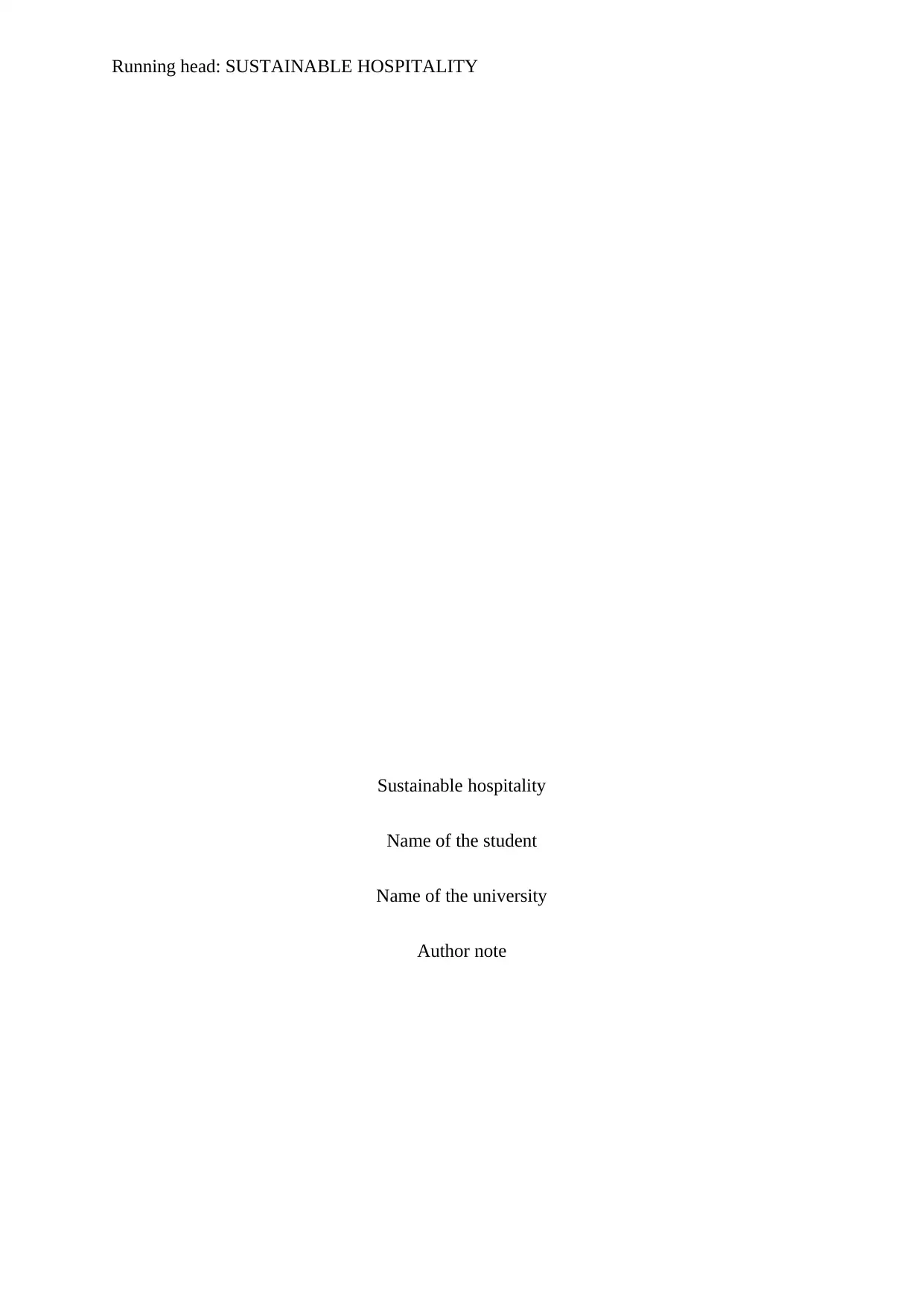
Running head: SUSTAINABLE HOSPITALITY
Sustainable hospitality
Name of the student
Name of the university
Author note
Sustainable hospitality
Name of the student
Name of the university
Author note
Secure Best Marks with AI Grader
Need help grading? Try our AI Grader for instant feedback on your assignments.
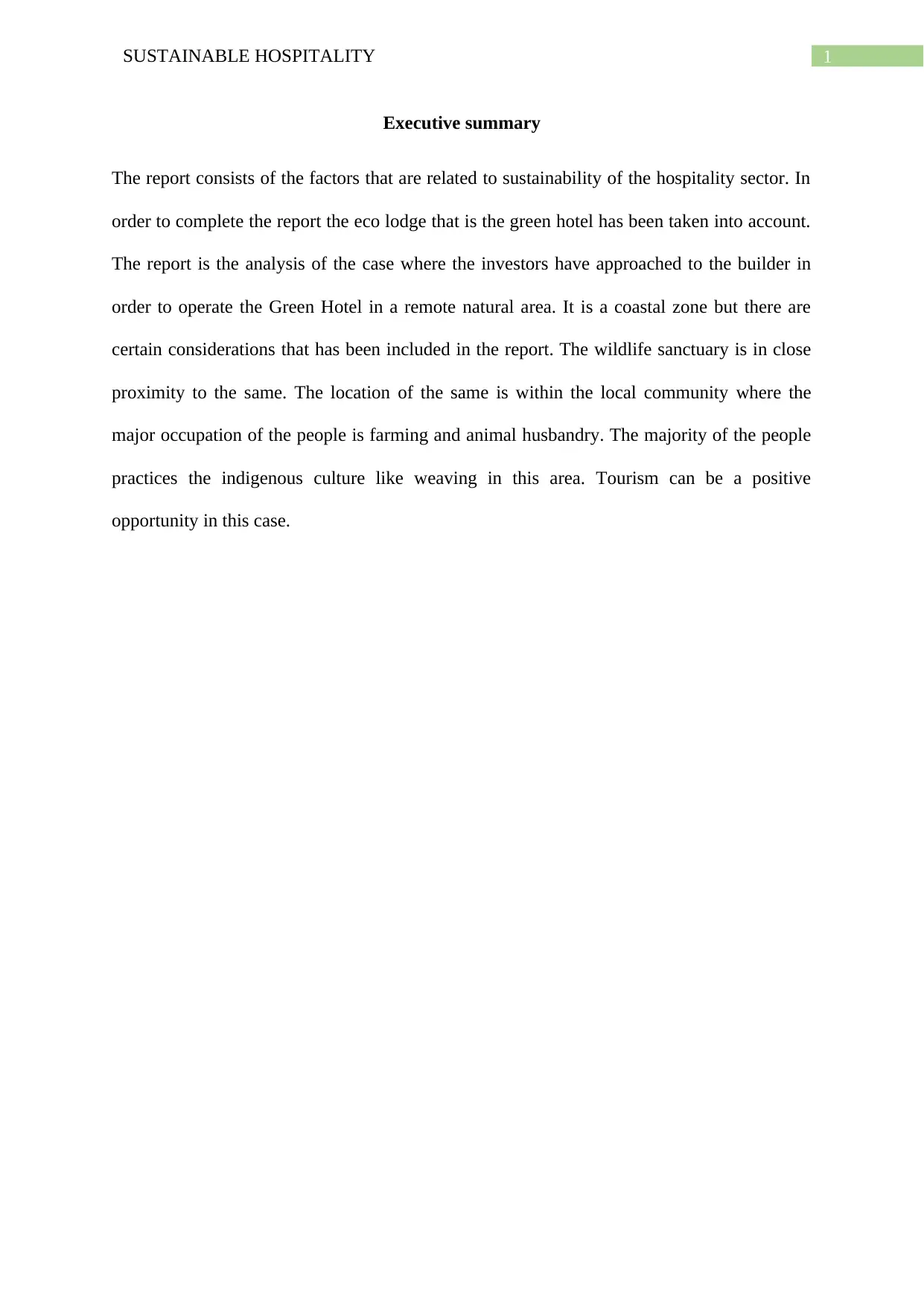
1SUSTAINABLE HOSPITALITY
Executive summary
The report consists of the factors that are related to sustainability of the hospitality sector. In
order to complete the report the eco lodge that is the green hotel has been taken into account.
The report is the analysis of the case where the investors have approached to the builder in
order to operate the Green Hotel in a remote natural area. It is a coastal zone but there are
certain considerations that has been included in the report. The wildlife sanctuary is in close
proximity to the same. The location of the same is within the local community where the
major occupation of the people is farming and animal husbandry. The majority of the people
practices the indigenous culture like weaving in this area. Tourism can be a positive
opportunity in this case.
Executive summary
The report consists of the factors that are related to sustainability of the hospitality sector. In
order to complete the report the eco lodge that is the green hotel has been taken into account.
The report is the analysis of the case where the investors have approached to the builder in
order to operate the Green Hotel in a remote natural area. It is a coastal zone but there are
certain considerations that has been included in the report. The wildlife sanctuary is in close
proximity to the same. The location of the same is within the local community where the
major occupation of the people is farming and animal husbandry. The majority of the people
practices the indigenous culture like weaving in this area. Tourism can be a positive
opportunity in this case.

2SUSTAINABLE HOSPITALITY
Table of Contents
Introduction:...............................................................................................................................6
Environmental management system:.........................................................................................6
Phase: 1: Initial review:.............................................................................................................7
a). Legal aspects:....................................................................................................................7
b). competitive aspects:..........................................................................................................7
Lower costs of the hotel:........................................................................................................7
Location in the natural community:.......................................................................................7
Corporate social responsibility:..............................................................................................8
Phase 2:......................................................................................................................................8
Information and commitment:....................................................................................................8
Phase 3:......................................................................................................................................8
Data assessment:........................................................................................................................8
Phase 4:......................................................................................................................................9
Analysis and training:................................................................................................................9
Phase 5:....................................................................................................................................10
Management system and documentation:................................................................................10
Phase 6:....................................................................................................................................11
Standard criteria: social/economic:..........................................................................................11
Support local entrepreneurs:................................................................................................13
Exploitation:.........................................................................................................................13
Table of Contents
Introduction:...............................................................................................................................6
Environmental management system:.........................................................................................6
Phase: 1: Initial review:.............................................................................................................7
a). Legal aspects:....................................................................................................................7
b). competitive aspects:..........................................................................................................7
Lower costs of the hotel:........................................................................................................7
Location in the natural community:.......................................................................................7
Corporate social responsibility:..............................................................................................8
Phase 2:......................................................................................................................................8
Information and commitment:....................................................................................................8
Phase 3:......................................................................................................................................8
Data assessment:........................................................................................................................8
Phase 4:......................................................................................................................................9
Analysis and training:................................................................................................................9
Phase 5:....................................................................................................................................10
Management system and documentation:................................................................................10
Phase 6:....................................................................................................................................11
Standard criteria: social/economic:..........................................................................................11
Support local entrepreneurs:................................................................................................13
Exploitation:.........................................................................................................................13
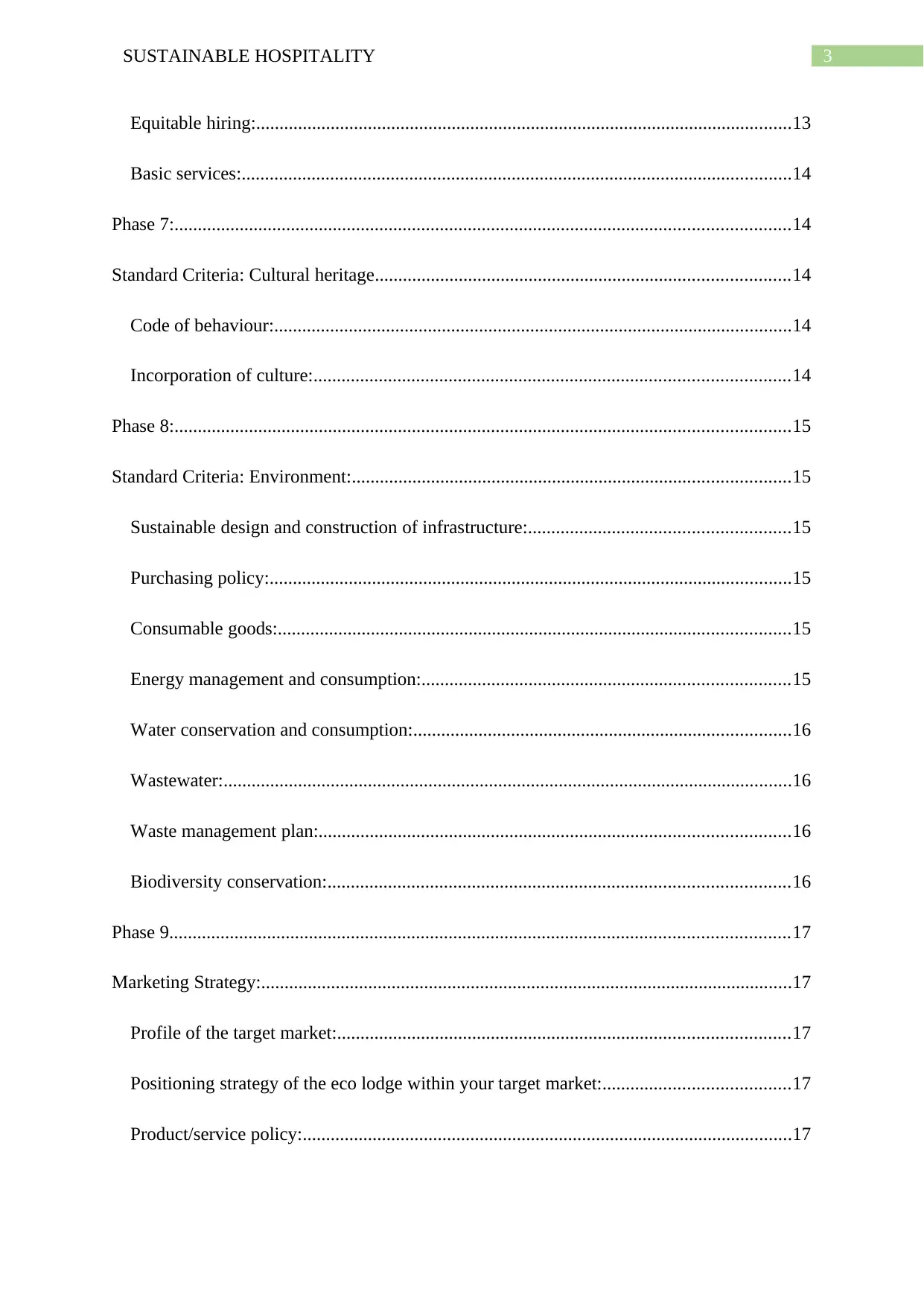
3SUSTAINABLE HOSPITALITY
Equitable hiring:...................................................................................................................13
Basic services:......................................................................................................................14
Phase 7:....................................................................................................................................14
Standard Criteria: Cultural heritage.........................................................................................14
Code of behaviour:...............................................................................................................14
Incorporation of culture:......................................................................................................14
Phase 8:....................................................................................................................................15
Standard Criteria: Environment:..............................................................................................15
Sustainable design and construction of infrastructure:........................................................15
Purchasing policy:................................................................................................................15
Consumable goods:..............................................................................................................15
Energy management and consumption:...............................................................................15
Water conservation and consumption:.................................................................................16
Wastewater:..........................................................................................................................16
Waste management plan:.....................................................................................................16
Biodiversity conservation:...................................................................................................16
Phase 9.....................................................................................................................................17
Marketing Strategy:..................................................................................................................17
Profile of the target market:.................................................................................................17
Positioning strategy of the eco lodge within your target market:........................................17
Product/service policy:.........................................................................................................17
Equitable hiring:...................................................................................................................13
Basic services:......................................................................................................................14
Phase 7:....................................................................................................................................14
Standard Criteria: Cultural heritage.........................................................................................14
Code of behaviour:...............................................................................................................14
Incorporation of culture:......................................................................................................14
Phase 8:....................................................................................................................................15
Standard Criteria: Environment:..............................................................................................15
Sustainable design and construction of infrastructure:........................................................15
Purchasing policy:................................................................................................................15
Consumable goods:..............................................................................................................15
Energy management and consumption:...............................................................................15
Water conservation and consumption:.................................................................................16
Wastewater:..........................................................................................................................16
Waste management plan:.....................................................................................................16
Biodiversity conservation:...................................................................................................16
Phase 9.....................................................................................................................................17
Marketing Strategy:..................................................................................................................17
Profile of the target market:.................................................................................................17
Positioning strategy of the eco lodge within your target market:........................................17
Product/service policy:.........................................................................................................17
Secure Best Marks with AI Grader
Need help grading? Try our AI Grader for instant feedback on your assignments.
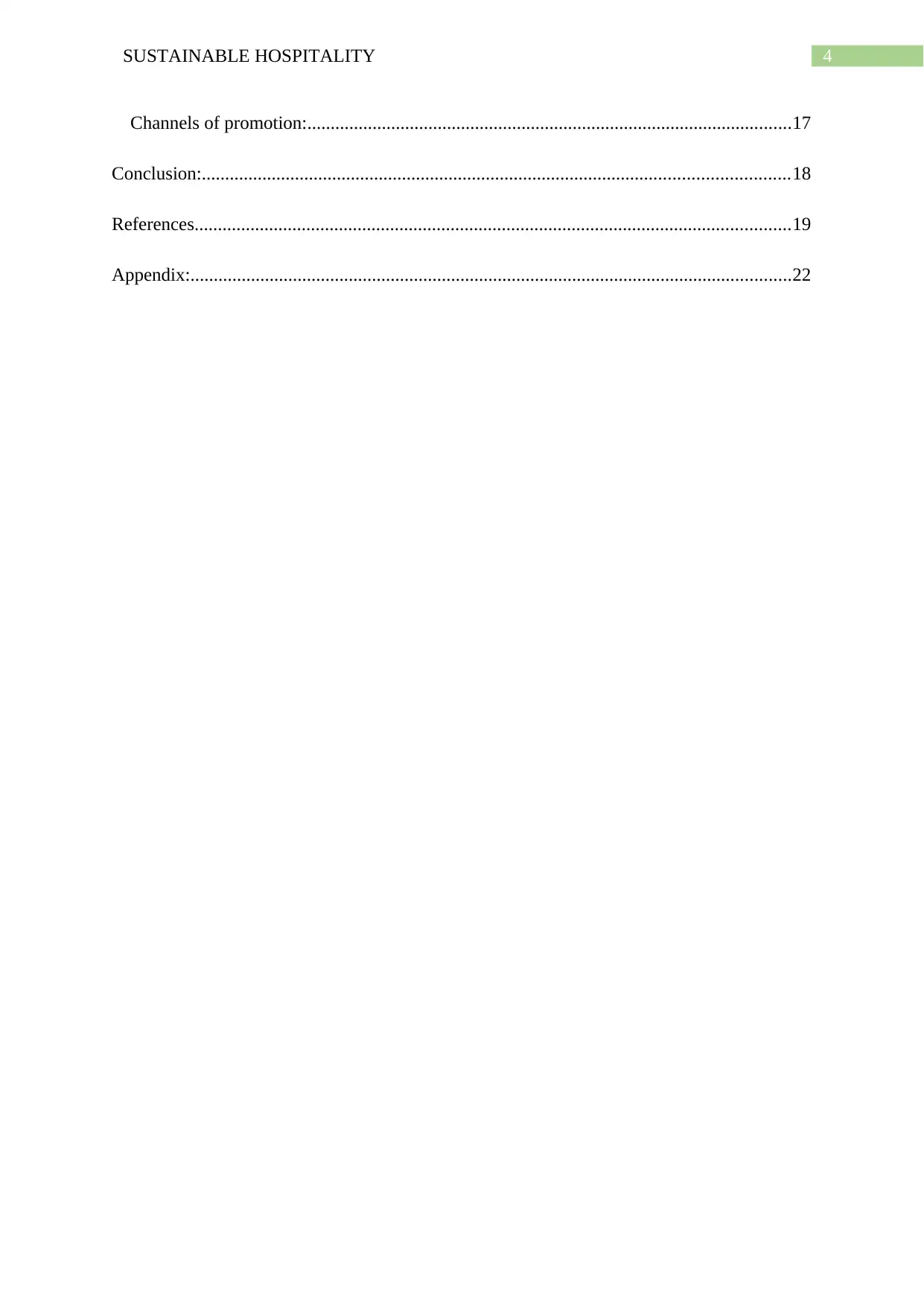
4SUSTAINABLE HOSPITALITY
Channels of promotion:........................................................................................................17
Conclusion:..............................................................................................................................18
References................................................................................................................................19
Appendix:.................................................................................................................................22
Channels of promotion:........................................................................................................17
Conclusion:..............................................................................................................................18
References................................................................................................................................19
Appendix:.................................................................................................................................22
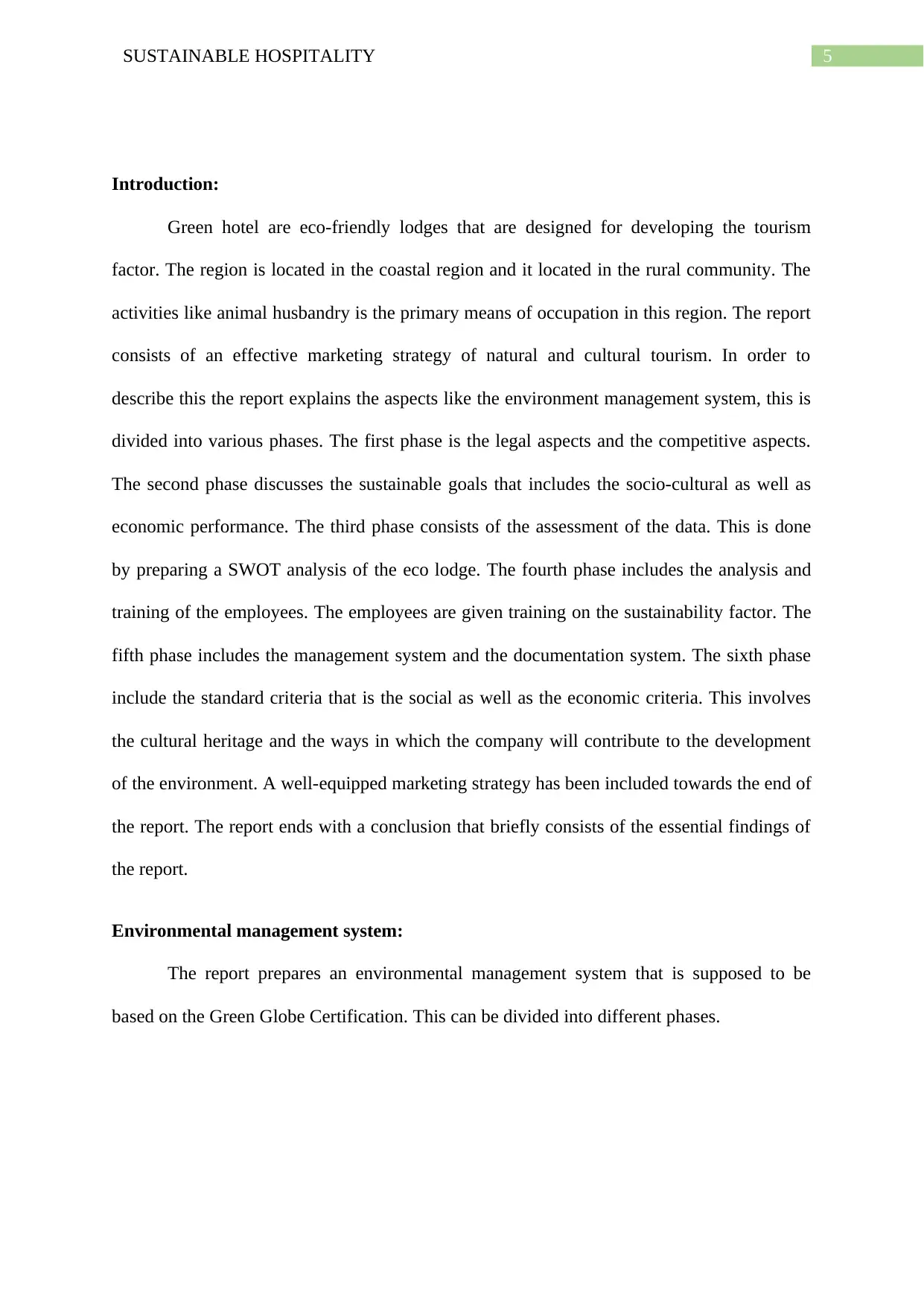
5SUSTAINABLE HOSPITALITY
Introduction:
Green hotel are eco-friendly lodges that are designed for developing the tourism
factor. The region is located in the coastal region and it located in the rural community. The
activities like animal husbandry is the primary means of occupation in this region. The report
consists of an effective marketing strategy of natural and cultural tourism. In order to
describe this the report explains the aspects like the environment management system, this is
divided into various phases. The first phase is the legal aspects and the competitive aspects.
The second phase discusses the sustainable goals that includes the socio-cultural as well as
economic performance. The third phase consists of the assessment of the data. This is done
by preparing a SWOT analysis of the eco lodge. The fourth phase includes the analysis and
training of the employees. The employees are given training on the sustainability factor. The
fifth phase includes the management system and the documentation system. The sixth phase
include the standard criteria that is the social as well as the economic criteria. This involves
the cultural heritage and the ways in which the company will contribute to the development
of the environment. A well-equipped marketing strategy has been included towards the end of
the report. The report ends with a conclusion that briefly consists of the essential findings of
the report.
Environmental management system:
The report prepares an environmental management system that is supposed to be
based on the Green Globe Certification. This can be divided into different phases.
Introduction:
Green hotel are eco-friendly lodges that are designed for developing the tourism
factor. The region is located in the coastal region and it located in the rural community. The
activities like animal husbandry is the primary means of occupation in this region. The report
consists of an effective marketing strategy of natural and cultural tourism. In order to
describe this the report explains the aspects like the environment management system, this is
divided into various phases. The first phase is the legal aspects and the competitive aspects.
The second phase discusses the sustainable goals that includes the socio-cultural as well as
economic performance. The third phase consists of the assessment of the data. This is done
by preparing a SWOT analysis of the eco lodge. The fourth phase includes the analysis and
training of the employees. The employees are given training on the sustainability factor. The
fifth phase includes the management system and the documentation system. The sixth phase
include the standard criteria that is the social as well as the economic criteria. This involves
the cultural heritage and the ways in which the company will contribute to the development
of the environment. A well-equipped marketing strategy has been included towards the end of
the report. The report ends with a conclusion that briefly consists of the essential findings of
the report.
Environmental management system:
The report prepares an environmental management system that is supposed to be
based on the Green Globe Certification. This can be divided into different phases.
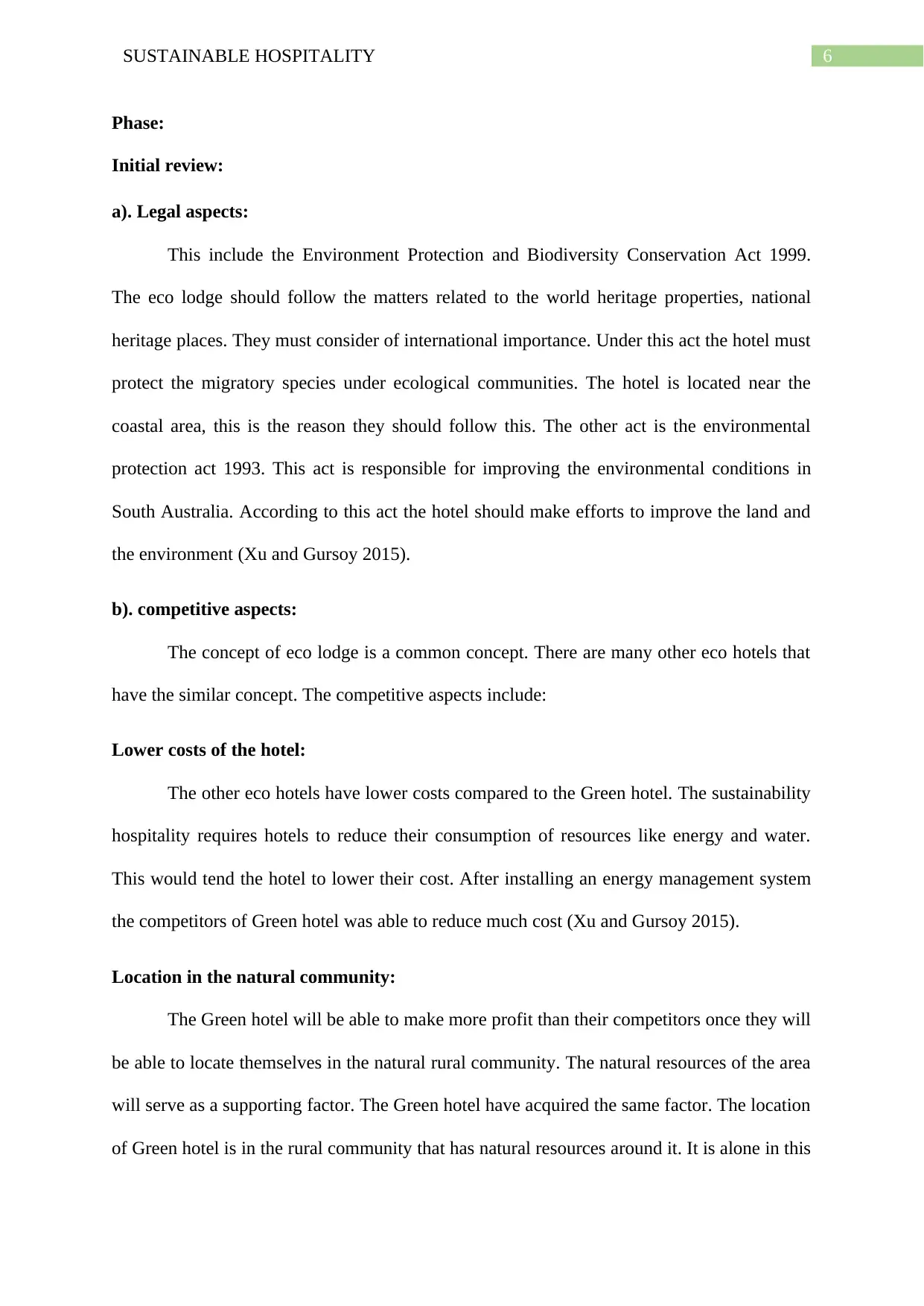
6SUSTAINABLE HOSPITALITY
Phase:
Initial review:
a). Legal aspects:
This include the Environment Protection and Biodiversity Conservation Act 1999.
The eco lodge should follow the matters related to the world heritage properties, national
heritage places. They must consider of international importance. Under this act the hotel must
protect the migratory species under ecological communities. The hotel is located near the
coastal area, this is the reason they should follow this. The other act is the environmental
protection act 1993. This act is responsible for improving the environmental conditions in
South Australia. According to this act the hotel should make efforts to improve the land and
the environment (Xu and Gursoy 2015).
b). competitive aspects:
The concept of eco lodge is a common concept. There are many other eco hotels that
have the similar concept. The competitive aspects include:
Lower costs of the hotel:
The other eco hotels have lower costs compared to the Green hotel. The sustainability
hospitality requires hotels to reduce their consumption of resources like energy and water.
This would tend the hotel to lower their cost. After installing an energy management system
the competitors of Green hotel was able to reduce much cost (Xu and Gursoy 2015).
Location in the natural community:
The Green hotel will be able to make more profit than their competitors once they will
be able to locate themselves in the natural rural community. The natural resources of the area
will serve as a supporting factor. The Green hotel have acquired the same factor. The location
of Green hotel is in the rural community that has natural resources around it. It is alone in this
Phase:
Initial review:
a). Legal aspects:
This include the Environment Protection and Biodiversity Conservation Act 1999.
The eco lodge should follow the matters related to the world heritage properties, national
heritage places. They must consider of international importance. Under this act the hotel must
protect the migratory species under ecological communities. The hotel is located near the
coastal area, this is the reason they should follow this. The other act is the environmental
protection act 1993. This act is responsible for improving the environmental conditions in
South Australia. According to this act the hotel should make efforts to improve the land and
the environment (Xu and Gursoy 2015).
b). competitive aspects:
The concept of eco lodge is a common concept. There are many other eco hotels that
have the similar concept. The competitive aspects include:
Lower costs of the hotel:
The other eco hotels have lower costs compared to the Green hotel. The sustainability
hospitality requires hotels to reduce their consumption of resources like energy and water.
This would tend the hotel to lower their cost. After installing an energy management system
the competitors of Green hotel was able to reduce much cost (Xu and Gursoy 2015).
Location in the natural community:
The Green hotel will be able to make more profit than their competitors once they will
be able to locate themselves in the natural rural community. The natural resources of the area
will serve as a supporting factor. The Green hotel have acquired the same factor. The location
of Green hotel is in the rural community that has natural resources around it. It is alone in this
Paraphrase This Document
Need a fresh take? Get an instant paraphrase of this document with our AI Paraphraser
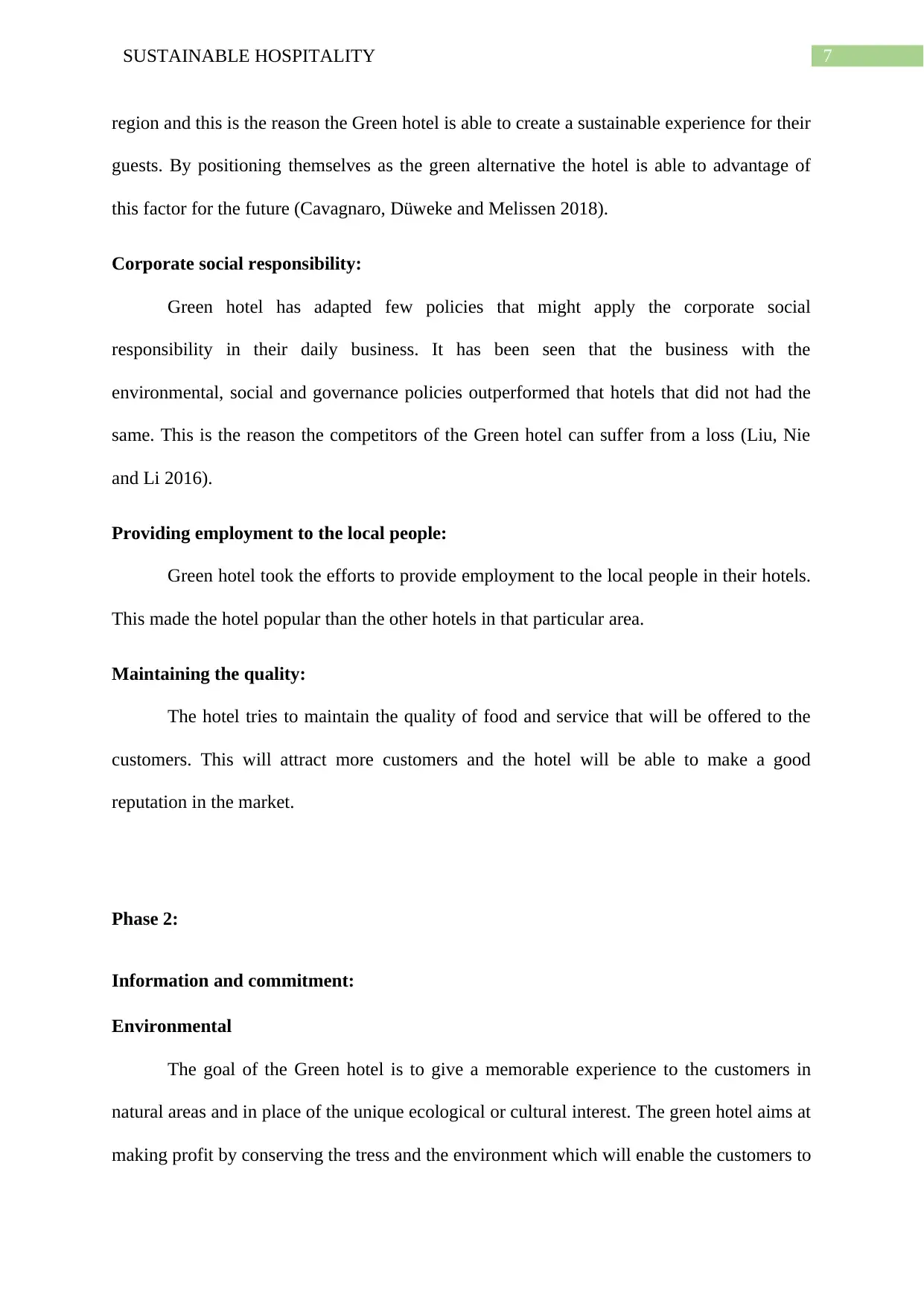
7SUSTAINABLE HOSPITALITY
region and this is the reason the Green hotel is able to create a sustainable experience for their
guests. By positioning themselves as the green alternative the hotel is able to advantage of
this factor for the future (Cavagnaro, Düweke and Melissen 2018).
Corporate social responsibility:
Green hotel has adapted few policies that might apply the corporate social
responsibility in their daily business. It has been seen that the business with the
environmental, social and governance policies outperformed that hotels that did not had the
same. This is the reason the competitors of the Green hotel can suffer from a loss (Liu, Nie
and Li 2016).
Providing employment to the local people:
Green hotel took the efforts to provide employment to the local people in their hotels.
This made the hotel popular than the other hotels in that particular area.
Maintaining the quality:
The hotel tries to maintain the quality of food and service that will be offered to the
customers. This will attract more customers and the hotel will be able to make a good
reputation in the market.
Phase 2:
Information and commitment:
Environmental
The goal of the Green hotel is to give a memorable experience to the customers in
natural areas and in place of the unique ecological or cultural interest. The green hotel aims at
making profit by conserving the tress and the environment which will enable the customers to
region and this is the reason the Green hotel is able to create a sustainable experience for their
guests. By positioning themselves as the green alternative the hotel is able to advantage of
this factor for the future (Cavagnaro, Düweke and Melissen 2018).
Corporate social responsibility:
Green hotel has adapted few policies that might apply the corporate social
responsibility in their daily business. It has been seen that the business with the
environmental, social and governance policies outperformed that hotels that did not had the
same. This is the reason the competitors of the Green hotel can suffer from a loss (Liu, Nie
and Li 2016).
Providing employment to the local people:
Green hotel took the efforts to provide employment to the local people in their hotels.
This made the hotel popular than the other hotels in that particular area.
Maintaining the quality:
The hotel tries to maintain the quality of food and service that will be offered to the
customers. This will attract more customers and the hotel will be able to make a good
reputation in the market.
Phase 2:
Information and commitment:
Environmental
The goal of the Green hotel is to give a memorable experience to the customers in
natural areas and in place of the unique ecological or cultural interest. The green hotel aims at
making profit by conserving the tress and the environment which will enable the customers to
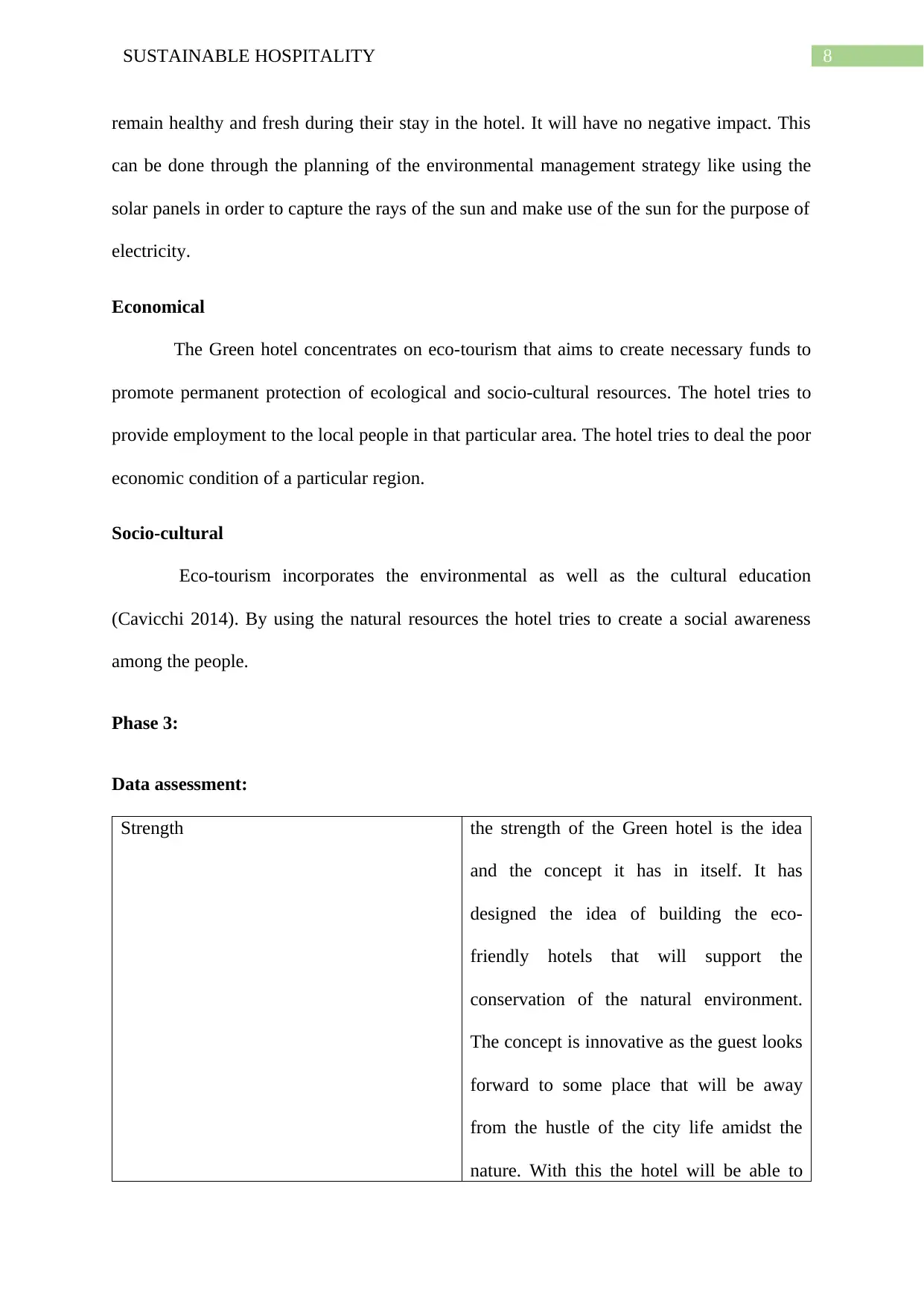
8SUSTAINABLE HOSPITALITY
remain healthy and fresh during their stay in the hotel. It will have no negative impact. This
can be done through the planning of the environmental management strategy like using the
solar panels in order to capture the rays of the sun and make use of the sun for the purpose of
electricity.
Economical
The Green hotel concentrates on eco-tourism that aims to create necessary funds to
promote permanent protection of ecological and socio-cultural resources. The hotel tries to
provide employment to the local people in that particular area. The hotel tries to deal the poor
economic condition of a particular region.
Socio-cultural
Eco-tourism incorporates the environmental as well as the cultural education
(Cavicchi 2014). By using the natural resources the hotel tries to create a social awareness
among the people.
Phase 3:
Data assessment:
Strength the strength of the Green hotel is the idea
and the concept it has in itself. It has
designed the idea of building the eco-
friendly hotels that will support the
conservation of the natural environment.
The concept is innovative as the guest looks
forward to some place that will be away
from the hustle of the city life amidst the
nature. With this the hotel will be able to
remain healthy and fresh during their stay in the hotel. It will have no negative impact. This
can be done through the planning of the environmental management strategy like using the
solar panels in order to capture the rays of the sun and make use of the sun for the purpose of
electricity.
Economical
The Green hotel concentrates on eco-tourism that aims to create necessary funds to
promote permanent protection of ecological and socio-cultural resources. The hotel tries to
provide employment to the local people in that particular area. The hotel tries to deal the poor
economic condition of a particular region.
Socio-cultural
Eco-tourism incorporates the environmental as well as the cultural education
(Cavicchi 2014). By using the natural resources the hotel tries to create a social awareness
among the people.
Phase 3:
Data assessment:
Strength the strength of the Green hotel is the idea
and the concept it has in itself. It has
designed the idea of building the eco-
friendly hotels that will support the
conservation of the natural environment.
The concept is innovative as the guest looks
forward to some place that will be away
from the hustle of the city life amidst the
nature. With this the hotel will be able to
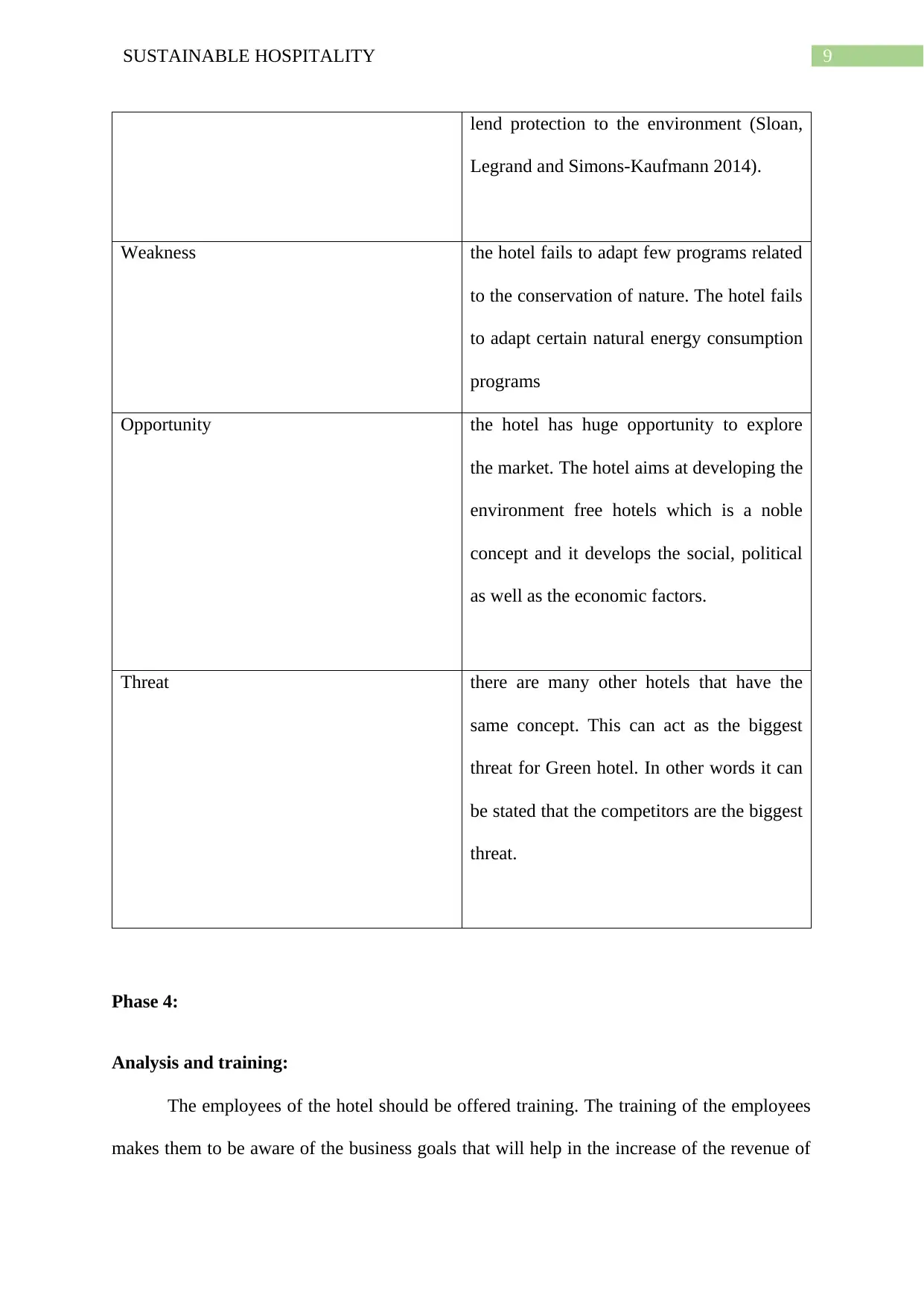
9SUSTAINABLE HOSPITALITY
lend protection to the environment (Sloan,
Legrand and Simons-Kaufmann 2014).
Weakness the hotel fails to adapt few programs related
to the conservation of nature. The hotel fails
to adapt certain natural energy consumption
programs
Opportunity the hotel has huge opportunity to explore
the market. The hotel aims at developing the
environment free hotels which is a noble
concept and it develops the social, political
as well as the economic factors.
Threat there are many other hotels that have the
same concept. This can act as the biggest
threat for Green hotel. In other words it can
be stated that the competitors are the biggest
threat.
Phase 4:
Analysis and training:
The employees of the hotel should be offered training. The training of the employees
makes them to be aware of the business goals that will help in the increase of the revenue of
lend protection to the environment (Sloan,
Legrand and Simons-Kaufmann 2014).
Weakness the hotel fails to adapt few programs related
to the conservation of nature. The hotel fails
to adapt certain natural energy consumption
programs
Opportunity the hotel has huge opportunity to explore
the market. The hotel aims at developing the
environment free hotels which is a noble
concept and it develops the social, political
as well as the economic factors.
Threat there are many other hotels that have the
same concept. This can act as the biggest
threat for Green hotel. In other words it can
be stated that the competitors are the biggest
threat.
Phase 4:
Analysis and training:
The employees of the hotel should be offered training. The training of the employees
makes them to be aware of the business goals that will help in the increase of the revenue of
Secure Best Marks with AI Grader
Need help grading? Try our AI Grader for instant feedback on your assignments.
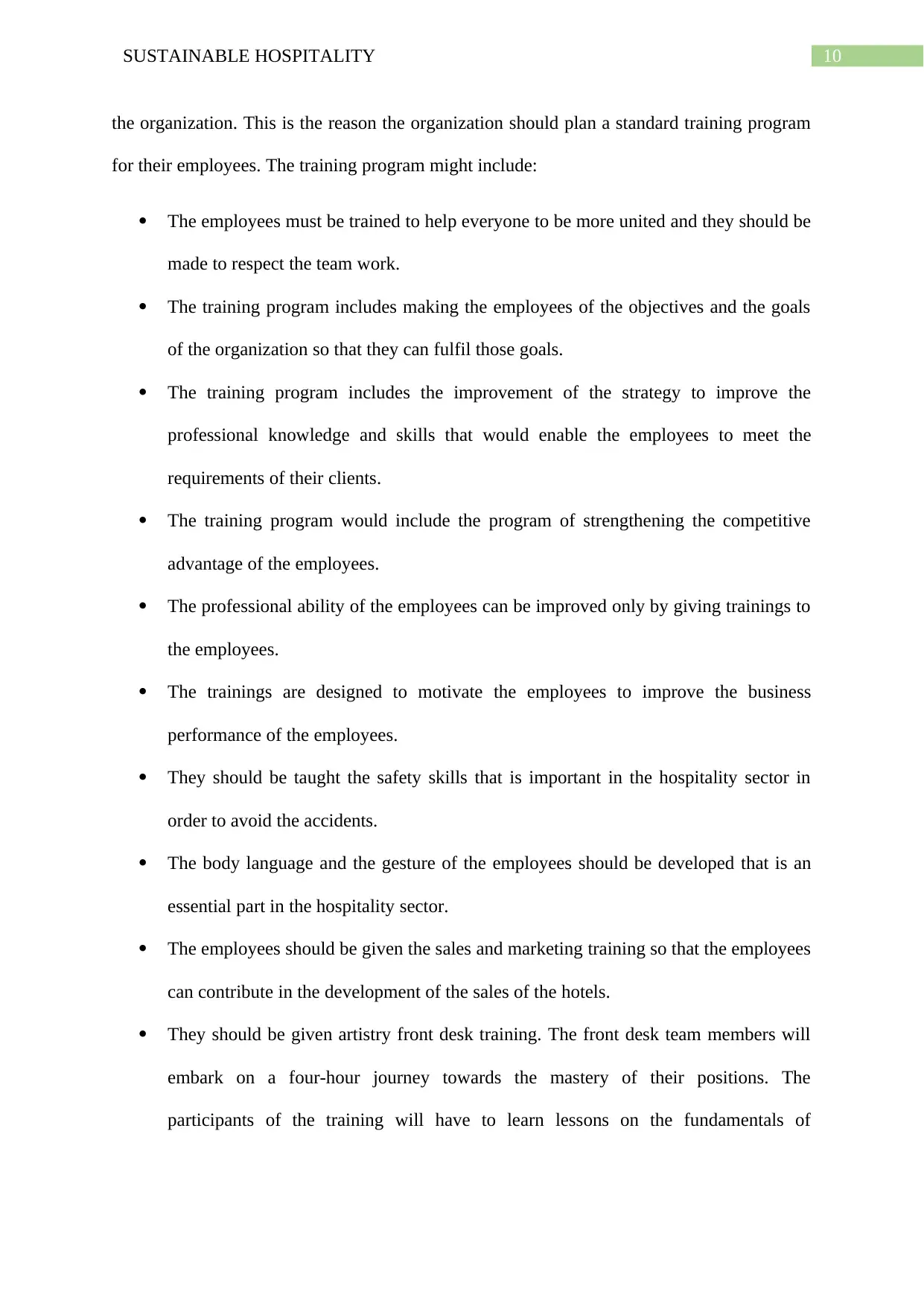
10SUSTAINABLE HOSPITALITY
the organization. This is the reason the organization should plan a standard training program
for their employees. The training program might include:
The employees must be trained to help everyone to be more united and they should be
made to respect the team work.
The training program includes making the employees of the objectives and the goals
of the organization so that they can fulfil those goals.
The training program includes the improvement of the strategy to improve the
professional knowledge and skills that would enable the employees to meet the
requirements of their clients.
The training program would include the program of strengthening the competitive
advantage of the employees.
The professional ability of the employees can be improved only by giving trainings to
the employees.
The trainings are designed to motivate the employees to improve the business
performance of the employees.
They should be taught the safety skills that is important in the hospitality sector in
order to avoid the accidents.
The body language and the gesture of the employees should be developed that is an
essential part in the hospitality sector.
The employees should be given the sales and marketing training so that the employees
can contribute in the development of the sales of the hotels.
They should be given artistry front desk training. The front desk team members will
embark on a four-hour journey towards the mastery of their positions. The
participants of the training will have to learn lessons on the fundamentals of
the organization. This is the reason the organization should plan a standard training program
for their employees. The training program might include:
The employees must be trained to help everyone to be more united and they should be
made to respect the team work.
The training program includes making the employees of the objectives and the goals
of the organization so that they can fulfil those goals.
The training program includes the improvement of the strategy to improve the
professional knowledge and skills that would enable the employees to meet the
requirements of their clients.
The training program would include the program of strengthening the competitive
advantage of the employees.
The professional ability of the employees can be improved only by giving trainings to
the employees.
The trainings are designed to motivate the employees to improve the business
performance of the employees.
They should be taught the safety skills that is important in the hospitality sector in
order to avoid the accidents.
The body language and the gesture of the employees should be developed that is an
essential part in the hospitality sector.
The employees should be given the sales and marketing training so that the employees
can contribute in the development of the sales of the hotels.
They should be given artistry front desk training. The front desk team members will
embark on a four-hour journey towards the mastery of their positions. The
participants of the training will have to learn lessons on the fundamentals of

11SUSTAINABLE HOSPITALITY
hospitality, communication and the reason to adopt the environmental products
(Prud’homme and Raymond 2016).
Phase 5:
Management system and documentation:
The satisfaction of the customers is one of the major aspect that should be considered
by the hotels. The facilities that are given to the customers can be checked or controlled by
taking feedbacks from the customers. The customers visits any hotels to have a memorable
experience. It is the responsibility of the hotels to make the stay of the guests comfortable.
The service can be improved once the area where the hotel is lacking is known and this is
possible only the feedbacks from the customers are collected. This include the 4 aspects:
Surveys: the feedback from the customers can be collected by conducting surveys
where questionnaires can be circulated where the customers can rate the service with
the help of likert scale. This is an easy process to collect the data and analyse the
same.
Feedback boxes: In this the customers can submit their feedback by dropping their
feedback in the feedback boxes. It can happen many times that the hotel lacks
something that the customers might want in such case the customers can drop this in
the feedback boxes.
Asking directly: this includes asking the customers directly about the service. The
associates directly goes to the customers and asks to them about their service and
what are the things that could be included to make the service better.
User activity: it would enable the customers to highlight the areas which is liked by
them the most and the areas which is disliked by them the most (Bunakov et al.
2015).
hospitality, communication and the reason to adopt the environmental products
(Prud’homme and Raymond 2016).
Phase 5:
Management system and documentation:
The satisfaction of the customers is one of the major aspect that should be considered
by the hotels. The facilities that are given to the customers can be checked or controlled by
taking feedbacks from the customers. The customers visits any hotels to have a memorable
experience. It is the responsibility of the hotels to make the stay of the guests comfortable.
The service can be improved once the area where the hotel is lacking is known and this is
possible only the feedbacks from the customers are collected. This include the 4 aspects:
Surveys: the feedback from the customers can be collected by conducting surveys
where questionnaires can be circulated where the customers can rate the service with
the help of likert scale. This is an easy process to collect the data and analyse the
same.
Feedback boxes: In this the customers can submit their feedback by dropping their
feedback in the feedback boxes. It can happen many times that the hotel lacks
something that the customers might want in such case the customers can drop this in
the feedback boxes.
Asking directly: this includes asking the customers directly about the service. The
associates directly goes to the customers and asks to them about their service and
what are the things that could be included to make the service better.
User activity: it would enable the customers to highlight the areas which is liked by
them the most and the areas which is disliked by them the most (Bunakov et al.
2015).
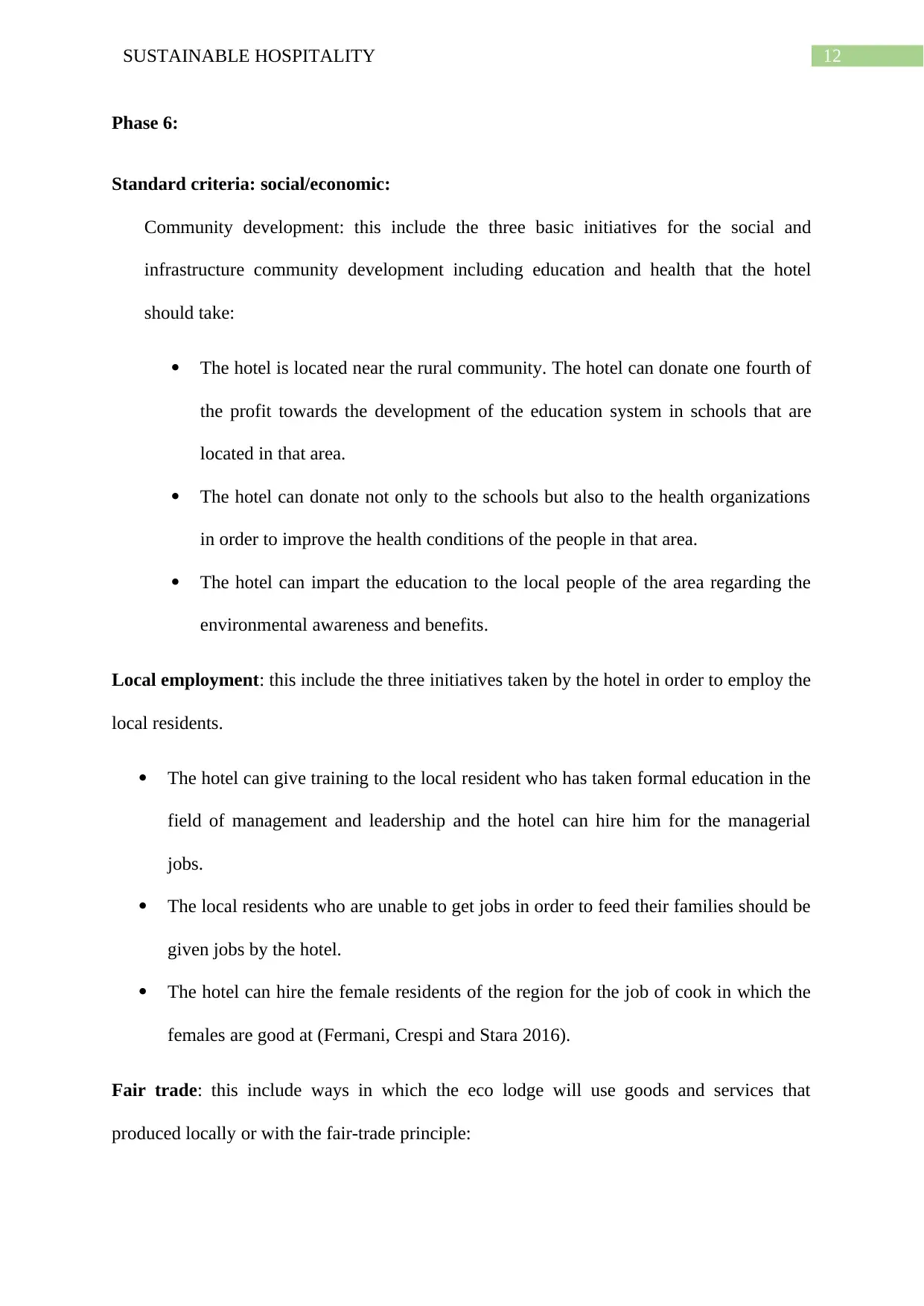
12SUSTAINABLE HOSPITALITY
Phase 6:
Standard criteria: social/economic:
Community development: this include the three basic initiatives for the social and
infrastructure community development including education and health that the hotel
should take:
The hotel is located near the rural community. The hotel can donate one fourth of
the profit towards the development of the education system in schools that are
located in that area.
The hotel can donate not only to the schools but also to the health organizations
in order to improve the health conditions of the people in that area.
The hotel can impart the education to the local people of the area regarding the
environmental awareness and benefits.
Local employment: this include the three initiatives taken by the hotel in order to employ the
local residents.
The hotel can give training to the local resident who has taken formal education in the
field of management and leadership and the hotel can hire him for the managerial
jobs.
The local residents who are unable to get jobs in order to feed their families should be
given jobs by the hotel.
The hotel can hire the female residents of the region for the job of cook in which the
females are good at (Fermani, Crespi and Stara 2016).
Fair trade: this include ways in which the eco lodge will use goods and services that
produced locally or with the fair-trade principle:
Phase 6:
Standard criteria: social/economic:
Community development: this include the three basic initiatives for the social and
infrastructure community development including education and health that the hotel
should take:
The hotel is located near the rural community. The hotel can donate one fourth of
the profit towards the development of the education system in schools that are
located in that area.
The hotel can donate not only to the schools but also to the health organizations
in order to improve the health conditions of the people in that area.
The hotel can impart the education to the local people of the area regarding the
environmental awareness and benefits.
Local employment: this include the three initiatives taken by the hotel in order to employ the
local residents.
The hotel can give training to the local resident who has taken formal education in the
field of management and leadership and the hotel can hire him for the managerial
jobs.
The local residents who are unable to get jobs in order to feed their families should be
given jobs by the hotel.
The hotel can hire the female residents of the region for the job of cook in which the
females are good at (Fermani, Crespi and Stara 2016).
Fair trade: this include ways in which the eco lodge will use goods and services that
produced locally or with the fair-trade principle:
Paraphrase This Document
Need a fresh take? Get an instant paraphrase of this document with our AI Paraphraser
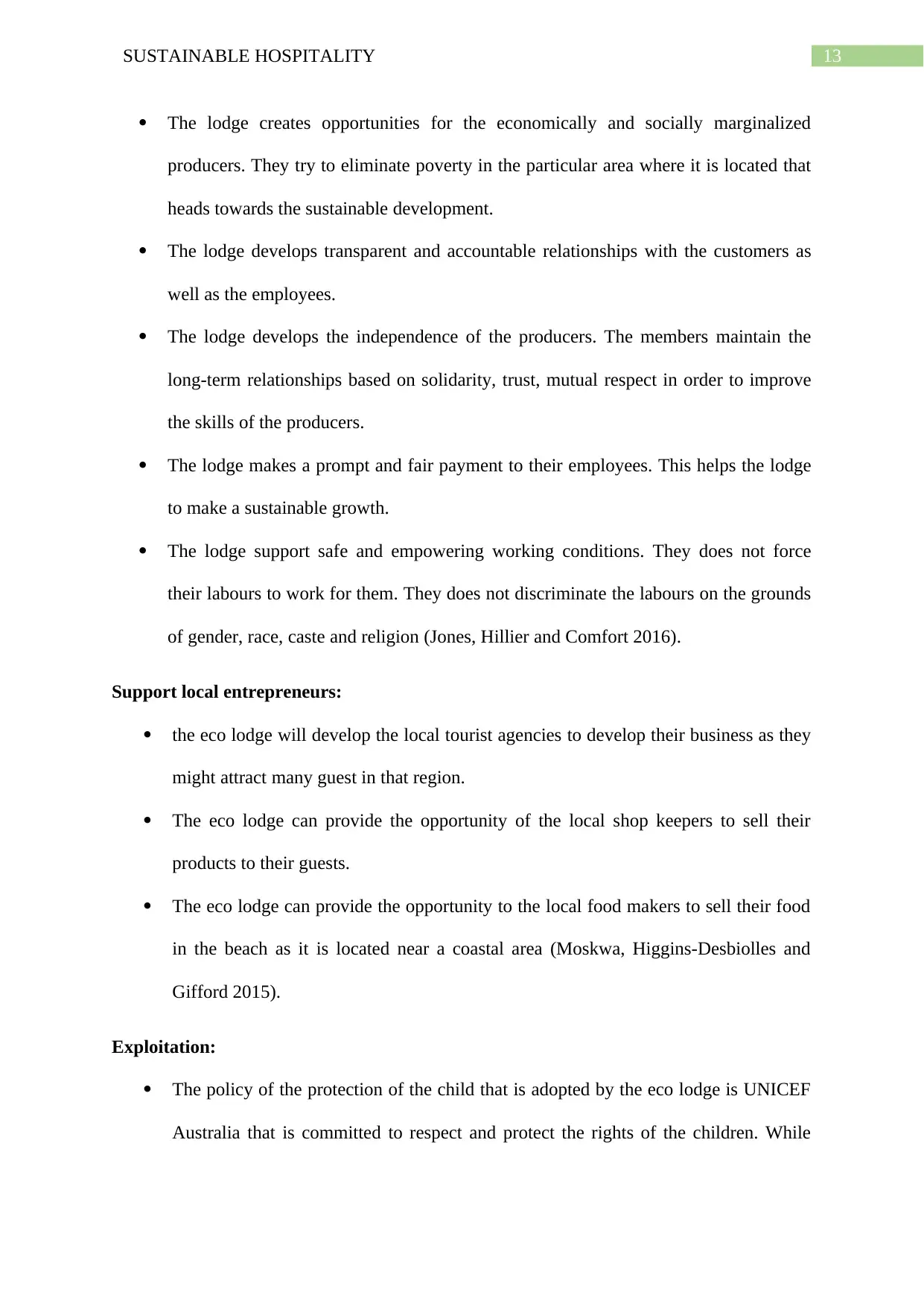
13SUSTAINABLE HOSPITALITY
The lodge creates opportunities for the economically and socially marginalized
producers. They try to eliminate poverty in the particular area where it is located that
heads towards the sustainable development.
The lodge develops transparent and accountable relationships with the customers as
well as the employees.
The lodge develops the independence of the producers. The members maintain the
long-term relationships based on solidarity, trust, mutual respect in order to improve
the skills of the producers.
The lodge makes a prompt and fair payment to their employees. This helps the lodge
to make a sustainable growth.
The lodge support safe and empowering working conditions. They does not force
their labours to work for them. They does not discriminate the labours on the grounds
of gender, race, caste and religion (Jones, Hillier and Comfort 2016).
Support local entrepreneurs:
the eco lodge will develop the local tourist agencies to develop their business as they
might attract many guest in that region.
The eco lodge can provide the opportunity of the local shop keepers to sell their
products to their guests.
The eco lodge can provide the opportunity to the local food makers to sell their food
in the beach as it is located near a coastal area (Moskwa, Higgins-Desbiolles and
Gifford 2015).
Exploitation:
The policy of the protection of the child that is adopted by the eco lodge is UNICEF
Australia that is committed to respect and protect the rights of the children. While
The lodge creates opportunities for the economically and socially marginalized
producers. They try to eliminate poverty in the particular area where it is located that
heads towards the sustainable development.
The lodge develops transparent and accountable relationships with the customers as
well as the employees.
The lodge develops the independence of the producers. The members maintain the
long-term relationships based on solidarity, trust, mutual respect in order to improve
the skills of the producers.
The lodge makes a prompt and fair payment to their employees. This helps the lodge
to make a sustainable growth.
The lodge support safe and empowering working conditions. They does not force
their labours to work for them. They does not discriminate the labours on the grounds
of gender, race, caste and religion (Jones, Hillier and Comfort 2016).
Support local entrepreneurs:
the eco lodge will develop the local tourist agencies to develop their business as they
might attract many guest in that region.
The eco lodge can provide the opportunity of the local shop keepers to sell their
products to their guests.
The eco lodge can provide the opportunity to the local food makers to sell their food
in the beach as it is located near a coastal area (Moskwa, Higgins-Desbiolles and
Gifford 2015).
Exploitation:
The policy of the protection of the child that is adopted by the eco lodge is UNICEF
Australia that is committed to respect and protect the rights of the children. While
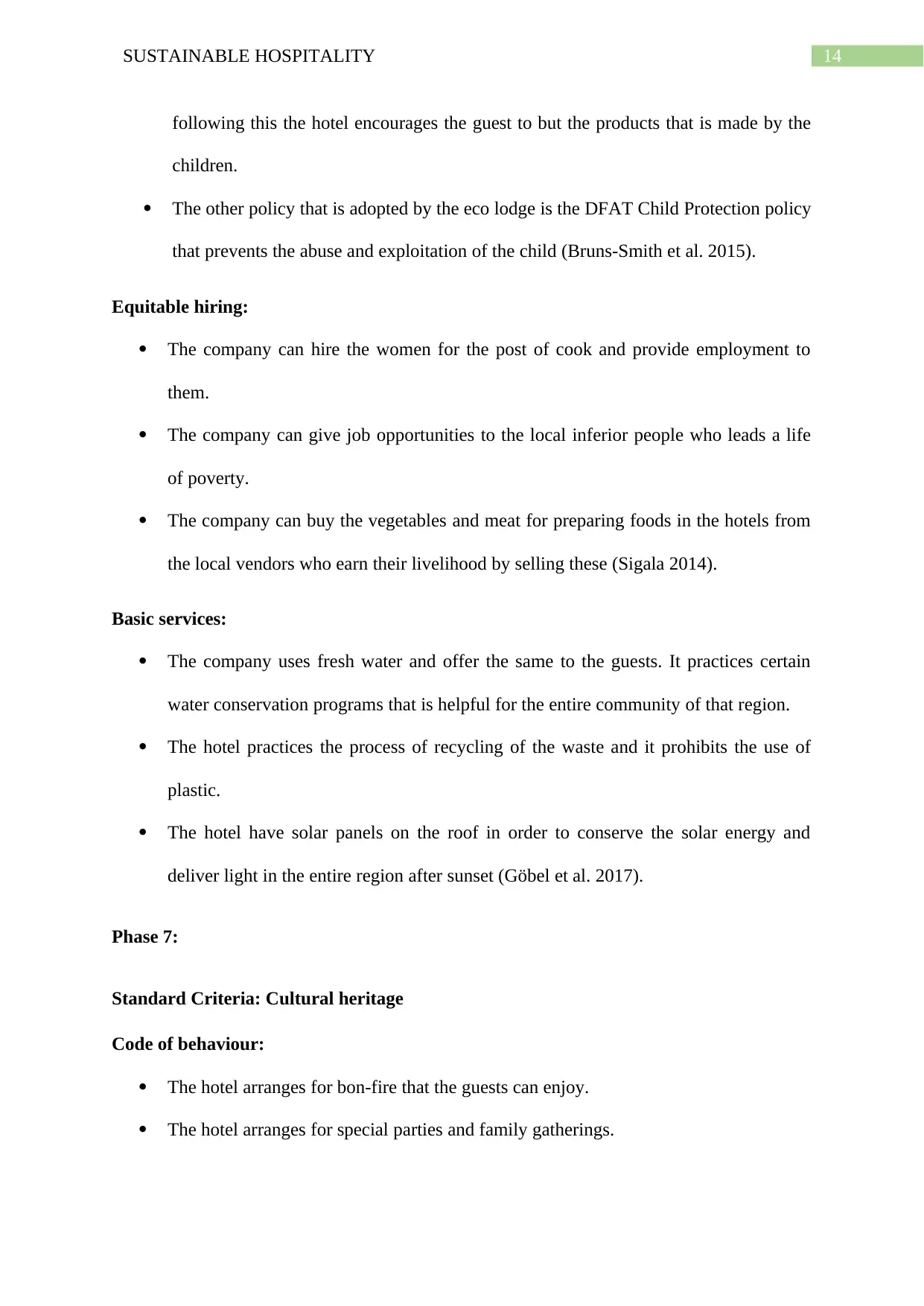
14SUSTAINABLE HOSPITALITY
following this the hotel encourages the guest to but the products that is made by the
children.
The other policy that is adopted by the eco lodge is the DFAT Child Protection policy
that prevents the abuse and exploitation of the child (Bruns-Smith et al. 2015).
Equitable hiring:
The company can hire the women for the post of cook and provide employment to
them.
The company can give job opportunities to the local inferior people who leads a life
of poverty.
The company can buy the vegetables and meat for preparing foods in the hotels from
the local vendors who earn their livelihood by selling these (Sigala 2014).
Basic services:
The company uses fresh water and offer the same to the guests. It practices certain
water conservation programs that is helpful for the entire community of that region.
The hotel practices the process of recycling of the waste and it prohibits the use of
plastic.
The hotel have solar panels on the roof in order to conserve the solar energy and
deliver light in the entire region after sunset (Göbel et al. 2017).
Phase 7:
Standard Criteria: Cultural heritage
Code of behaviour:
The hotel arranges for bon-fire that the guests can enjoy.
The hotel arranges for special parties and family gatherings.
following this the hotel encourages the guest to but the products that is made by the
children.
The other policy that is adopted by the eco lodge is the DFAT Child Protection policy
that prevents the abuse and exploitation of the child (Bruns-Smith et al. 2015).
Equitable hiring:
The company can hire the women for the post of cook and provide employment to
them.
The company can give job opportunities to the local inferior people who leads a life
of poverty.
The company can buy the vegetables and meat for preparing foods in the hotels from
the local vendors who earn their livelihood by selling these (Sigala 2014).
Basic services:
The company uses fresh water and offer the same to the guests. It practices certain
water conservation programs that is helpful for the entire community of that region.
The hotel practices the process of recycling of the waste and it prohibits the use of
plastic.
The hotel have solar panels on the roof in order to conserve the solar energy and
deliver light in the entire region after sunset (Göbel et al. 2017).
Phase 7:
Standard Criteria: Cultural heritage
Code of behaviour:
The hotel arranges for bon-fire that the guests can enjoy.
The hotel arranges for special parties and family gatherings.
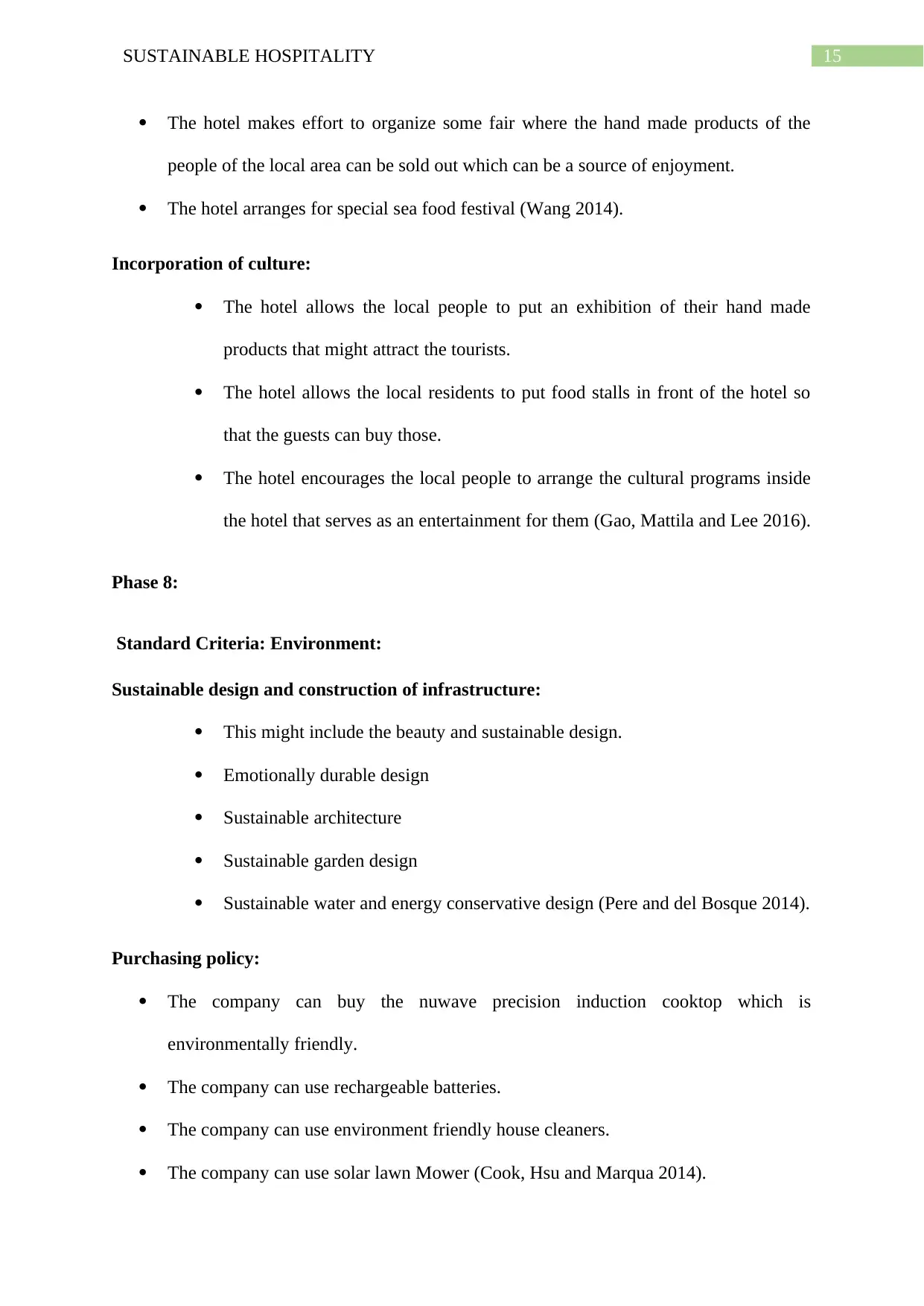
15SUSTAINABLE HOSPITALITY
The hotel makes effort to organize some fair where the hand made products of the
people of the local area can be sold out which can be a source of enjoyment.
The hotel arranges for special sea food festival (Wang 2014).
Incorporation of culture:
The hotel allows the local people to put an exhibition of their hand made
products that might attract the tourists.
The hotel allows the local residents to put food stalls in front of the hotel so
that the guests can buy those.
The hotel encourages the local people to arrange the cultural programs inside
the hotel that serves as an entertainment for them (Gao, Mattila and Lee 2016).
Phase 8:
Standard Criteria: Environment:
Sustainable design and construction of infrastructure:
This might include the beauty and sustainable design.
Emotionally durable design
Sustainable architecture
Sustainable garden design
Sustainable water and energy conservative design (Pere and del Bosque 2014).
Purchasing policy:
The company can buy the nuwave precision induction cooktop which is
environmentally friendly.
The company can use rechargeable batteries.
The company can use environment friendly house cleaners.
The company can use solar lawn Mower (Cook, Hsu and Marqua 2014).
The hotel makes effort to organize some fair where the hand made products of the
people of the local area can be sold out which can be a source of enjoyment.
The hotel arranges for special sea food festival (Wang 2014).
Incorporation of culture:
The hotel allows the local people to put an exhibition of their hand made
products that might attract the tourists.
The hotel allows the local residents to put food stalls in front of the hotel so
that the guests can buy those.
The hotel encourages the local people to arrange the cultural programs inside
the hotel that serves as an entertainment for them (Gao, Mattila and Lee 2016).
Phase 8:
Standard Criteria: Environment:
Sustainable design and construction of infrastructure:
This might include the beauty and sustainable design.
Emotionally durable design
Sustainable architecture
Sustainable garden design
Sustainable water and energy conservative design (Pere and del Bosque 2014).
Purchasing policy:
The company can buy the nuwave precision induction cooktop which is
environmentally friendly.
The company can use rechargeable batteries.
The company can use environment friendly house cleaners.
The company can use solar lawn Mower (Cook, Hsu and Marqua 2014).
Secure Best Marks with AI Grader
Need help grading? Try our AI Grader for instant feedback on your assignments.
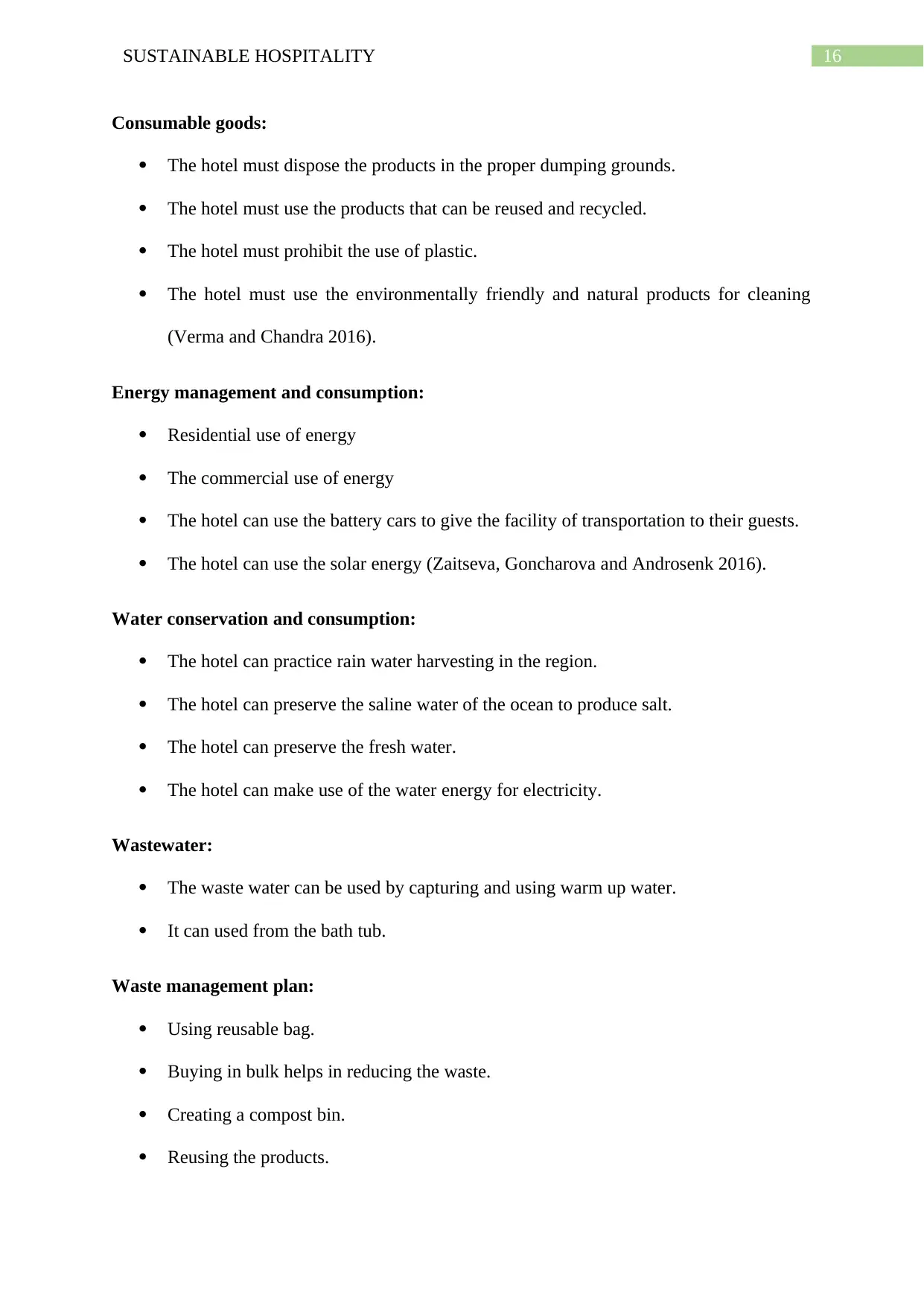
16SUSTAINABLE HOSPITALITY
Consumable goods:
The hotel must dispose the products in the proper dumping grounds.
The hotel must use the products that can be reused and recycled.
The hotel must prohibit the use of plastic.
The hotel must use the environmentally friendly and natural products for cleaning
(Verma and Chandra 2016).
Energy management and consumption:
Residential use of energy
The commercial use of energy
The hotel can use the battery cars to give the facility of transportation to their guests.
The hotel can use the solar energy (Zaitseva, Goncharova and Androsenk 2016).
Water conservation and consumption:
The hotel can practice rain water harvesting in the region.
The hotel can preserve the saline water of the ocean to produce salt.
The hotel can preserve the fresh water.
The hotel can make use of the water energy for electricity.
Wastewater:
The waste water can be used by capturing and using warm up water.
It can used from the bath tub.
Waste management plan:
Using reusable bag.
Buying in bulk helps in reducing the waste.
Creating a compost bin.
Reusing the products.
Consumable goods:
The hotel must dispose the products in the proper dumping grounds.
The hotel must use the products that can be reused and recycled.
The hotel must prohibit the use of plastic.
The hotel must use the environmentally friendly and natural products for cleaning
(Verma and Chandra 2016).
Energy management and consumption:
Residential use of energy
The commercial use of energy
The hotel can use the battery cars to give the facility of transportation to their guests.
The hotel can use the solar energy (Zaitseva, Goncharova and Androsenk 2016).
Water conservation and consumption:
The hotel can practice rain water harvesting in the region.
The hotel can preserve the saline water of the ocean to produce salt.
The hotel can preserve the fresh water.
The hotel can make use of the water energy for electricity.
Wastewater:
The waste water can be used by capturing and using warm up water.
It can used from the bath tub.
Waste management plan:
Using reusable bag.
Buying in bulk helps in reducing the waste.
Creating a compost bin.
Reusing the products.
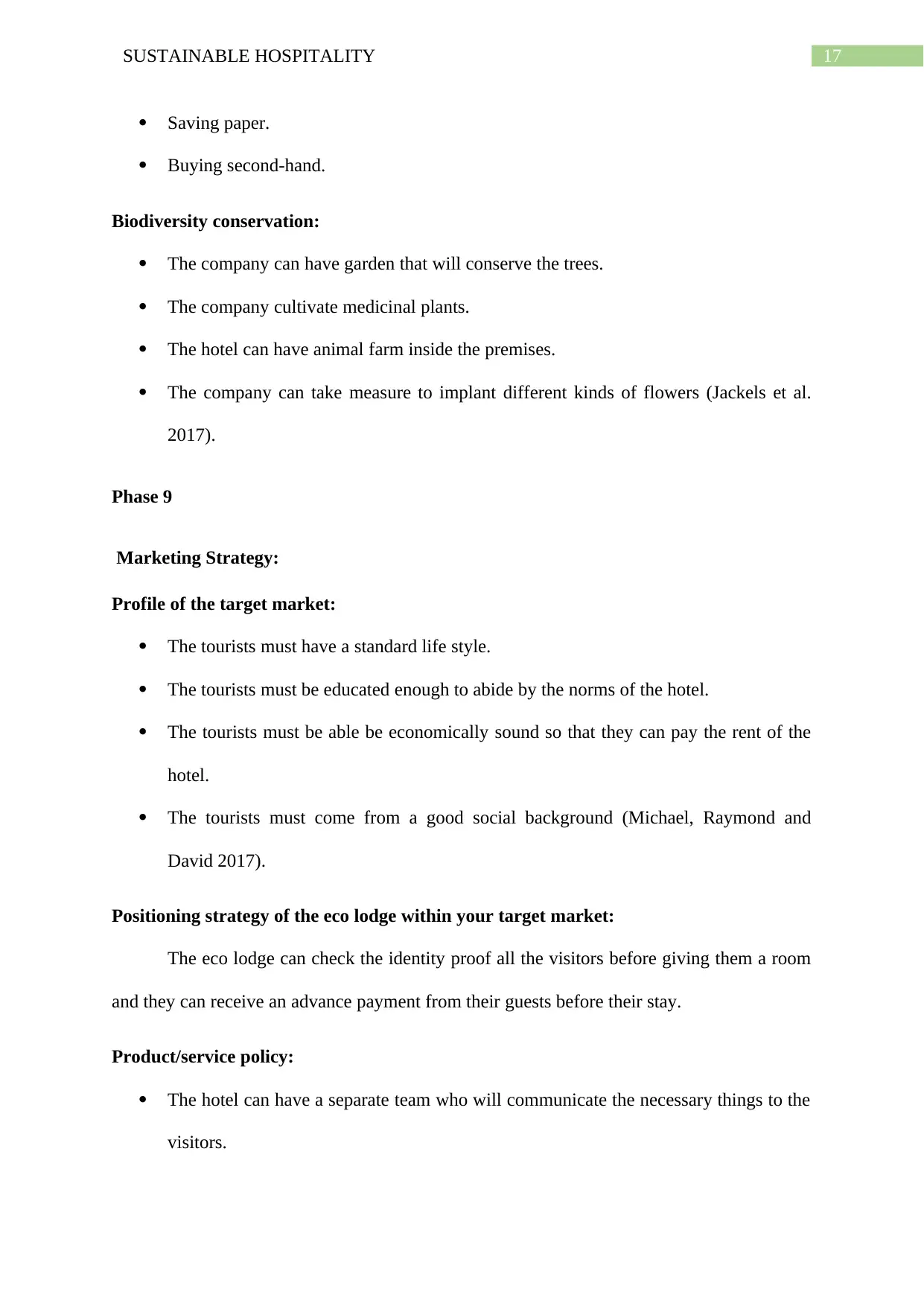
17SUSTAINABLE HOSPITALITY
Saving paper.
Buying second-hand.
Biodiversity conservation:
The company can have garden that will conserve the trees.
The company cultivate medicinal plants.
The hotel can have animal farm inside the premises.
The company can take measure to implant different kinds of flowers (Jackels et al.
2017).
Phase 9
Marketing Strategy:
Profile of the target market:
The tourists must have a standard life style.
The tourists must be educated enough to abide by the norms of the hotel.
The tourists must be able be economically sound so that they can pay the rent of the
hotel.
The tourists must come from a good social background (Michael, Raymond and
David 2017).
Positioning strategy of the eco lodge within your target market:
The eco lodge can check the identity proof all the visitors before giving them a room
and they can receive an advance payment from their guests before their stay.
Product/service policy:
The hotel can have a separate team who will communicate the necessary things to the
visitors.
Saving paper.
Buying second-hand.
Biodiversity conservation:
The company can have garden that will conserve the trees.
The company cultivate medicinal plants.
The hotel can have animal farm inside the premises.
The company can take measure to implant different kinds of flowers (Jackels et al.
2017).
Phase 9
Marketing Strategy:
Profile of the target market:
The tourists must have a standard life style.
The tourists must be educated enough to abide by the norms of the hotel.
The tourists must be able be economically sound so that they can pay the rent of the
hotel.
The tourists must come from a good social background (Michael, Raymond and
David 2017).
Positioning strategy of the eco lodge within your target market:
The eco lodge can check the identity proof all the visitors before giving them a room
and they can receive an advance payment from their guests before their stay.
Product/service policy:
The hotel can have a separate team who will communicate the necessary things to the
visitors.

18SUSTAINABLE HOSPITALITY
The hotel can mention about their norms and facilities on their official website itself.
The hotel can keep the copy of the same in every room and in the restaurant section
(La Rosa et al. 2018).
Channels of promotion:
Promotion in social networking sites
Promotion in banners and newspapers (Gratz et al. 2014).
Conclusion:
The idea of tourism can act as a good opportunity in that particular area. Apart from
this the other factor that should be considered is the Green Globe certification. Therefore the
report include the complete set of indicators that is necessary for the criteria of sustainability
that is outlined by the organization in the report. The report analyses the scenario where the
investors proposed an investment on building the Eco Lodge that is the Green hotel in a
remote natural area.
The hotel can mention about their norms and facilities on their official website itself.
The hotel can keep the copy of the same in every room and in the restaurant section
(La Rosa et al. 2018).
Channels of promotion:
Promotion in social networking sites
Promotion in banners and newspapers (Gratz et al. 2014).
Conclusion:
The idea of tourism can act as a good opportunity in that particular area. Apart from
this the other factor that should be considered is the Green Globe certification. Therefore the
report include the complete set of indicators that is necessary for the criteria of sustainability
that is outlined by the organization in the report. The report analyses the scenario where the
investors proposed an investment on building the Eco Lodge that is the Green hotel in a
remote natural area.
Paraphrase This Document
Need a fresh take? Get an instant paraphrase of this document with our AI Paraphraser

19SUSTAINABLE HOSPITALITY
References
Bruns-Smith, A., Choy, V., Chong Ph D, H. and Verma Ph D, R., 2015. Environmental
sustainability in the hospitality industry: Best practices, guest participation, and customer
satisfaction.
Bunakov, O.A., Zaitseva, N.A., Larionova, A.A., Chudnovskiy, A.D., Zhukova, M.A. and
Zhukov, V.A., 2015. Research on the evolution of management concepts of sustainable
tourism and hospitality development in the regions. Journal of Sustainable Development,
8(6), p.39.
Cavagnaro, E., Düweke, A. and Melissen, F., 2018. The host-guest relationship is the key to
sustainable hospitality: Lessons learned from a Dutch case study. Hospitality & Society, 8(1),
pp.23-44.
Cavicchi, A., 2014. Sustainable Hospitality and Tourism as Motors for Development. Case
Studies from Developing Regions of the World.
Cook, R.A., Hsu, C.H. and Marqua, J.J., 2014. Tourism: the business of hospitality and
travel. Boston, MA: Pearson.
Fermani, A., Crespi, I. and Stara, F., 2016. Sustainable hospitality and tourism at different
ages: Women’s and men’s attitudes in Italy. Research in Hospitality Management, 6(1),
pp.83-92.
Gao, Y.L., Mattila, A.S. and Lee, S., 2016. A meta-analysis of behavioral intentions for
environment-friendly initiatives in hospitality research. International Journal of Hospitality
Management, 54, pp.107-115.
Gratz, E., Sa, Q., Apelian, D. and Wang, Y., 2014. A closed loop process for recycling spent
lithium ion batteries. Journal of Power Sources, 262, pp.255-262.
References
Bruns-Smith, A., Choy, V., Chong Ph D, H. and Verma Ph D, R., 2015. Environmental
sustainability in the hospitality industry: Best practices, guest participation, and customer
satisfaction.
Bunakov, O.A., Zaitseva, N.A., Larionova, A.A., Chudnovskiy, A.D., Zhukova, M.A. and
Zhukov, V.A., 2015. Research on the evolution of management concepts of sustainable
tourism and hospitality development in the regions. Journal of Sustainable Development,
8(6), p.39.
Cavagnaro, E., Düweke, A. and Melissen, F., 2018. The host-guest relationship is the key to
sustainable hospitality: Lessons learned from a Dutch case study. Hospitality & Society, 8(1),
pp.23-44.
Cavicchi, A., 2014. Sustainable Hospitality and Tourism as Motors for Development. Case
Studies from Developing Regions of the World.
Cook, R.A., Hsu, C.H. and Marqua, J.J., 2014. Tourism: the business of hospitality and
travel. Boston, MA: Pearson.
Fermani, A., Crespi, I. and Stara, F., 2016. Sustainable hospitality and tourism at different
ages: Women’s and men’s attitudes in Italy. Research in Hospitality Management, 6(1),
pp.83-92.
Gao, Y.L., Mattila, A.S. and Lee, S., 2016. A meta-analysis of behavioral intentions for
environment-friendly initiatives in hospitality research. International Journal of Hospitality
Management, 54, pp.107-115.
Gratz, E., Sa, Q., Apelian, D. and Wang, Y., 2014. A closed loop process for recycling spent
lithium ion batteries. Journal of Power Sources, 262, pp.255-262.
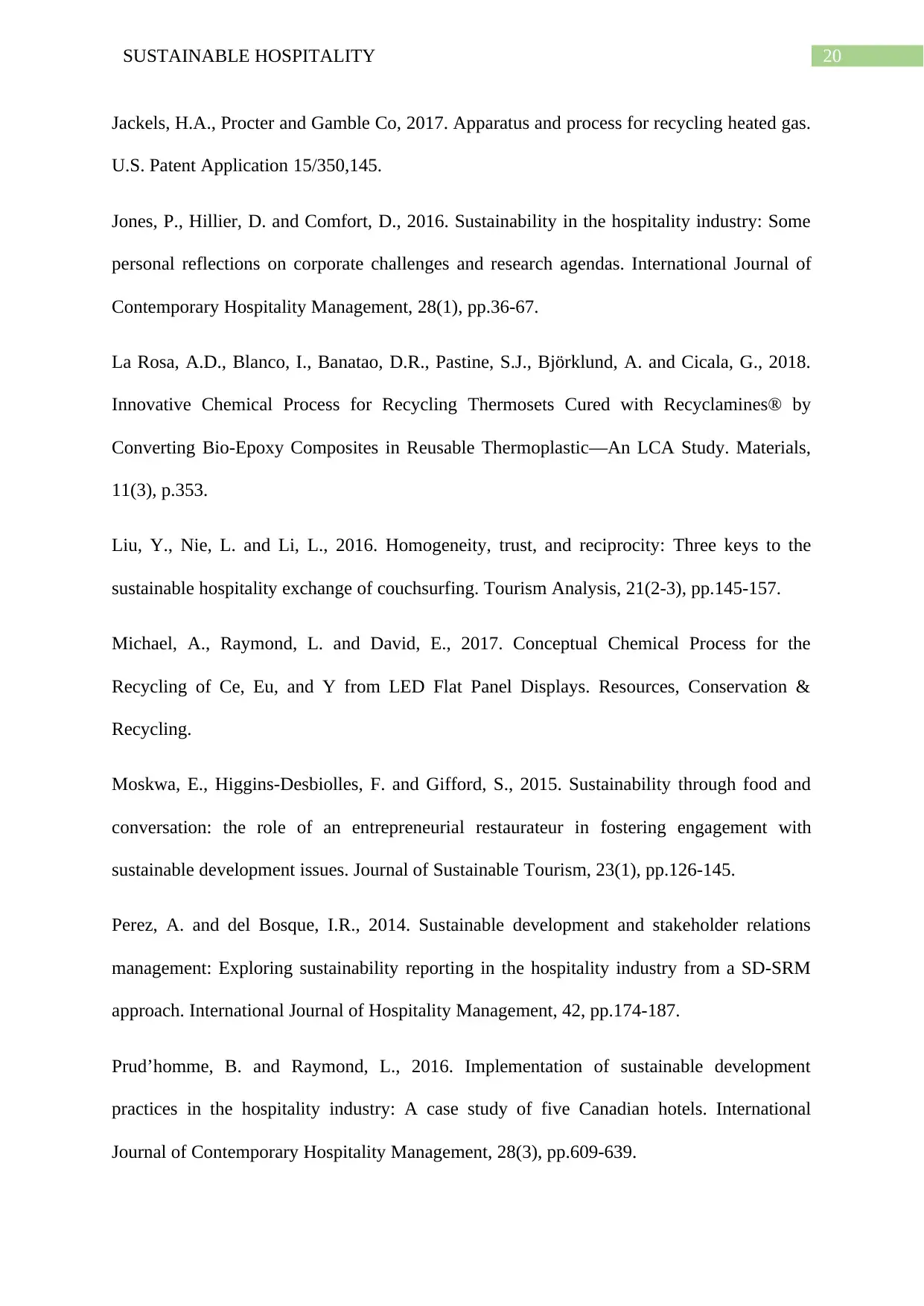
20SUSTAINABLE HOSPITALITY
Jackels, H.A., Procter and Gamble Co, 2017. Apparatus and process for recycling heated gas.
U.S. Patent Application 15/350,145.
Jones, P., Hillier, D. and Comfort, D., 2016. Sustainability in the hospitality industry: Some
personal reflections on corporate challenges and research agendas. International Journal of
Contemporary Hospitality Management, 28(1), pp.36-67.
La Rosa, A.D., Blanco, I., Banatao, D.R., Pastine, S.J., Björklund, A. and Cicala, G., 2018.
Innovative Chemical Process for Recycling Thermosets Cured with Recyclamines® by
Converting Bio-Epoxy Composites in Reusable Thermoplastic—An LCA Study. Materials,
11(3), p.353.
Liu, Y., Nie, L. and Li, L., 2016. Homogeneity, trust, and reciprocity: Three keys to the
sustainable hospitality exchange of couchsurfing. Tourism Analysis, 21(2-3), pp.145-157.
Michael, A., Raymond, L. and David, E., 2017. Conceptual Chemical Process for the
Recycling of Ce, Eu, and Y from LED Flat Panel Displays. Resources, Conservation &
Recycling.
Moskwa, E., Higgins-Desbiolles, F. and Gifford, S., 2015. Sustainability through food and
conversation: the role of an entrepreneurial restaurateur in fostering engagement with
sustainable development issues. Journal of Sustainable Tourism, 23(1), pp.126-145.
Perez, A. and del Bosque, I.R., 2014. Sustainable development and stakeholder relations
management: Exploring sustainability reporting in the hospitality industry from a SD-SRM
approach. International Journal of Hospitality Management, 42, pp.174-187.
Prud’homme, B. and Raymond, L., 2016. Implementation of sustainable development
practices in the hospitality industry: A case study of five Canadian hotels. International
Journal of Contemporary Hospitality Management, 28(3), pp.609-639.
Jackels, H.A., Procter and Gamble Co, 2017. Apparatus and process for recycling heated gas.
U.S. Patent Application 15/350,145.
Jones, P., Hillier, D. and Comfort, D., 2016. Sustainability in the hospitality industry: Some
personal reflections on corporate challenges and research agendas. International Journal of
Contemporary Hospitality Management, 28(1), pp.36-67.
La Rosa, A.D., Blanco, I., Banatao, D.R., Pastine, S.J., Björklund, A. and Cicala, G., 2018.
Innovative Chemical Process for Recycling Thermosets Cured with Recyclamines® by
Converting Bio-Epoxy Composites in Reusable Thermoplastic—An LCA Study. Materials,
11(3), p.353.
Liu, Y., Nie, L. and Li, L., 2016. Homogeneity, trust, and reciprocity: Three keys to the
sustainable hospitality exchange of couchsurfing. Tourism Analysis, 21(2-3), pp.145-157.
Michael, A., Raymond, L. and David, E., 2017. Conceptual Chemical Process for the
Recycling of Ce, Eu, and Y from LED Flat Panel Displays. Resources, Conservation &
Recycling.
Moskwa, E., Higgins-Desbiolles, F. and Gifford, S., 2015. Sustainability through food and
conversation: the role of an entrepreneurial restaurateur in fostering engagement with
sustainable development issues. Journal of Sustainable Tourism, 23(1), pp.126-145.
Perez, A. and del Bosque, I.R., 2014. Sustainable development and stakeholder relations
management: Exploring sustainability reporting in the hospitality industry from a SD-SRM
approach. International Journal of Hospitality Management, 42, pp.174-187.
Prud’homme, B. and Raymond, L., 2016. Implementation of sustainable development
practices in the hospitality industry: A case study of five Canadian hotels. International
Journal of Contemporary Hospitality Management, 28(3), pp.609-639.
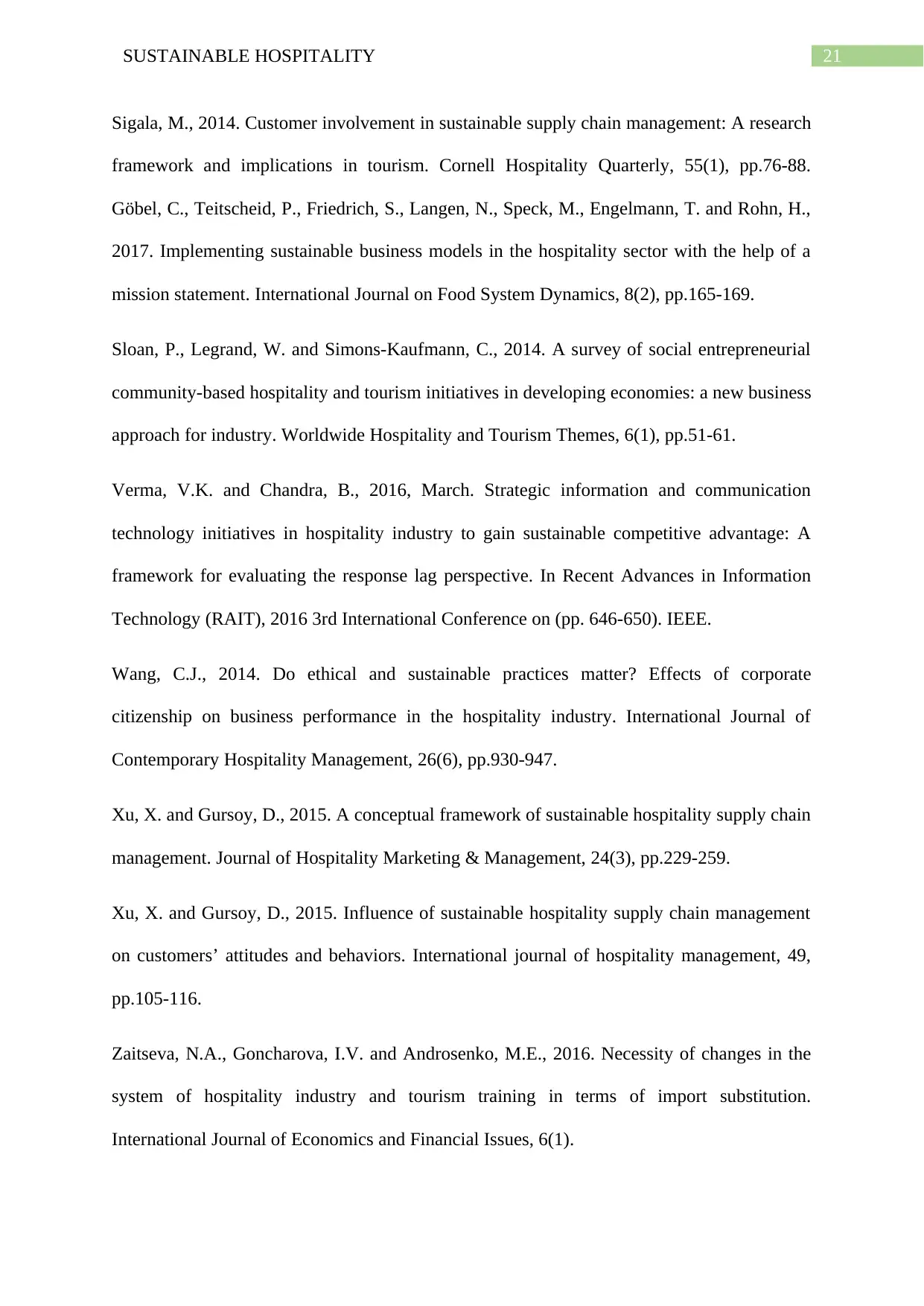
21SUSTAINABLE HOSPITALITY
Sigala, M., 2014. Customer involvement in sustainable supply chain management: A research
framework and implications in tourism. Cornell Hospitality Quarterly, 55(1), pp.76-88.
Göbel, C., Teitscheid, P., Friedrich, S., Langen, N., Speck, M., Engelmann, T. and Rohn, H.,
2017. Implementing sustainable business models in the hospitality sector with the help of a
mission statement. International Journal on Food System Dynamics, 8(2), pp.165-169.
Sloan, P., Legrand, W. and Simons-Kaufmann, C., 2014. A survey of social entrepreneurial
community-based hospitality and tourism initiatives in developing economies: a new business
approach for industry. Worldwide Hospitality and Tourism Themes, 6(1), pp.51-61.
Verma, V.K. and Chandra, B., 2016, March. Strategic information and communication
technology initiatives in hospitality industry to gain sustainable competitive advantage: A
framework for evaluating the response lag perspective. In Recent Advances in Information
Technology (RAIT), 2016 3rd International Conference on (pp. 646-650). IEEE.
Wang, C.J., 2014. Do ethical and sustainable practices matter? Effects of corporate
citizenship on business performance in the hospitality industry. International Journal of
Contemporary Hospitality Management, 26(6), pp.930-947.
Xu, X. and Gursoy, D., 2015. A conceptual framework of sustainable hospitality supply chain
management. Journal of Hospitality Marketing & Management, 24(3), pp.229-259.
Xu, X. and Gursoy, D., 2015. Influence of sustainable hospitality supply chain management
on customers’ attitudes and behaviors. International journal of hospitality management, 49,
pp.105-116.
Zaitseva, N.A., Goncharova, I.V. and Androsenko, M.E., 2016. Necessity of changes in the
system of hospitality industry and tourism training in terms of import substitution.
International Journal of Economics and Financial Issues, 6(1).
Sigala, M., 2014. Customer involvement in sustainable supply chain management: A research
framework and implications in tourism. Cornell Hospitality Quarterly, 55(1), pp.76-88.
Göbel, C., Teitscheid, P., Friedrich, S., Langen, N., Speck, M., Engelmann, T. and Rohn, H.,
2017. Implementing sustainable business models in the hospitality sector with the help of a
mission statement. International Journal on Food System Dynamics, 8(2), pp.165-169.
Sloan, P., Legrand, W. and Simons-Kaufmann, C., 2014. A survey of social entrepreneurial
community-based hospitality and tourism initiatives in developing economies: a new business
approach for industry. Worldwide Hospitality and Tourism Themes, 6(1), pp.51-61.
Verma, V.K. and Chandra, B., 2016, March. Strategic information and communication
technology initiatives in hospitality industry to gain sustainable competitive advantage: A
framework for evaluating the response lag perspective. In Recent Advances in Information
Technology (RAIT), 2016 3rd International Conference on (pp. 646-650). IEEE.
Wang, C.J., 2014. Do ethical and sustainable practices matter? Effects of corporate
citizenship on business performance in the hospitality industry. International Journal of
Contemporary Hospitality Management, 26(6), pp.930-947.
Xu, X. and Gursoy, D., 2015. A conceptual framework of sustainable hospitality supply chain
management. Journal of Hospitality Marketing & Management, 24(3), pp.229-259.
Xu, X. and Gursoy, D., 2015. Influence of sustainable hospitality supply chain management
on customers’ attitudes and behaviors. International journal of hospitality management, 49,
pp.105-116.
Zaitseva, N.A., Goncharova, I.V. and Androsenko, M.E., 2016. Necessity of changes in the
system of hospitality industry and tourism training in terms of import substitution.
International Journal of Economics and Financial Issues, 6(1).
Secure Best Marks with AI Grader
Need help grading? Try our AI Grader for instant feedback on your assignments.
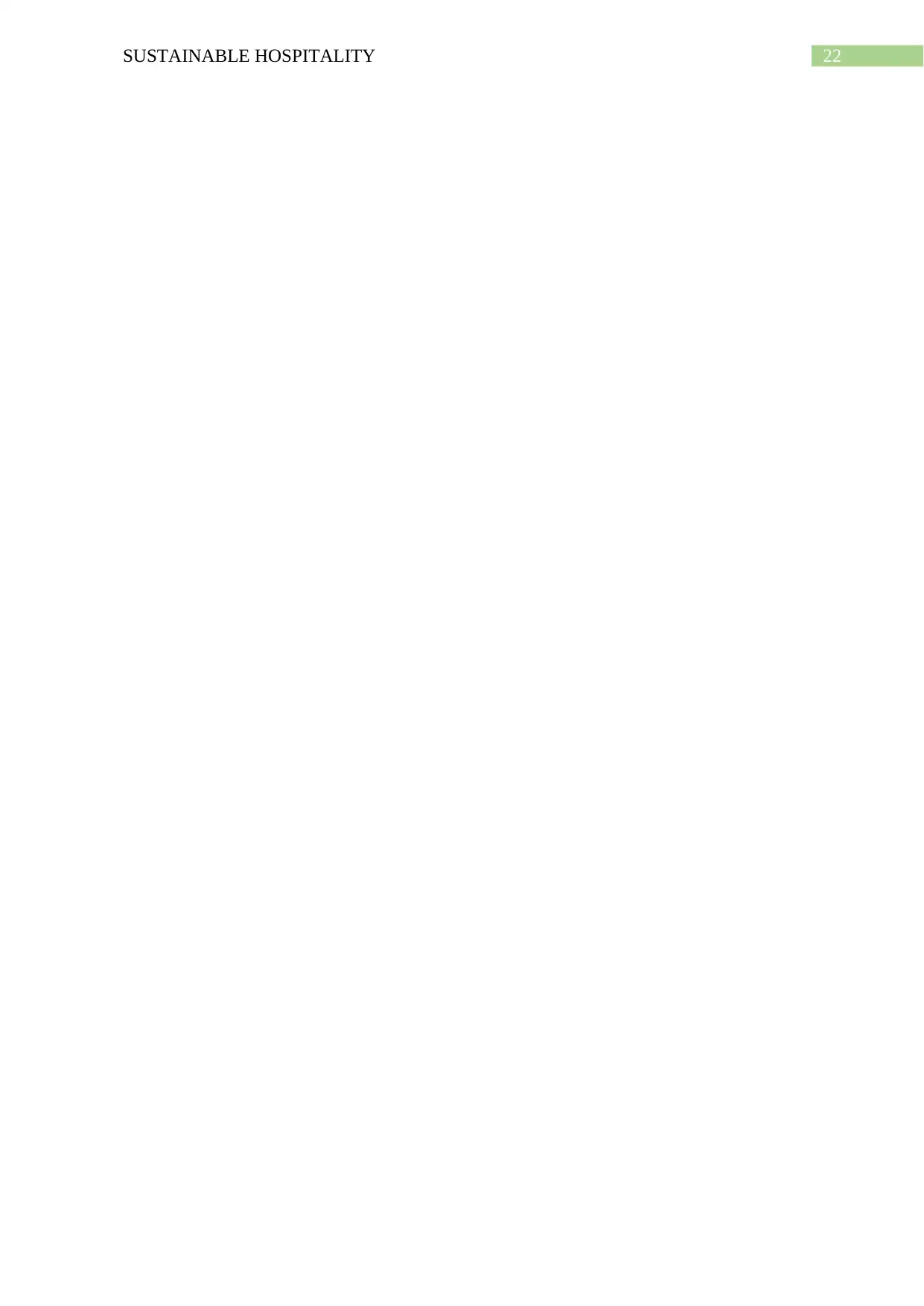
22SUSTAINABLE HOSPITALITY
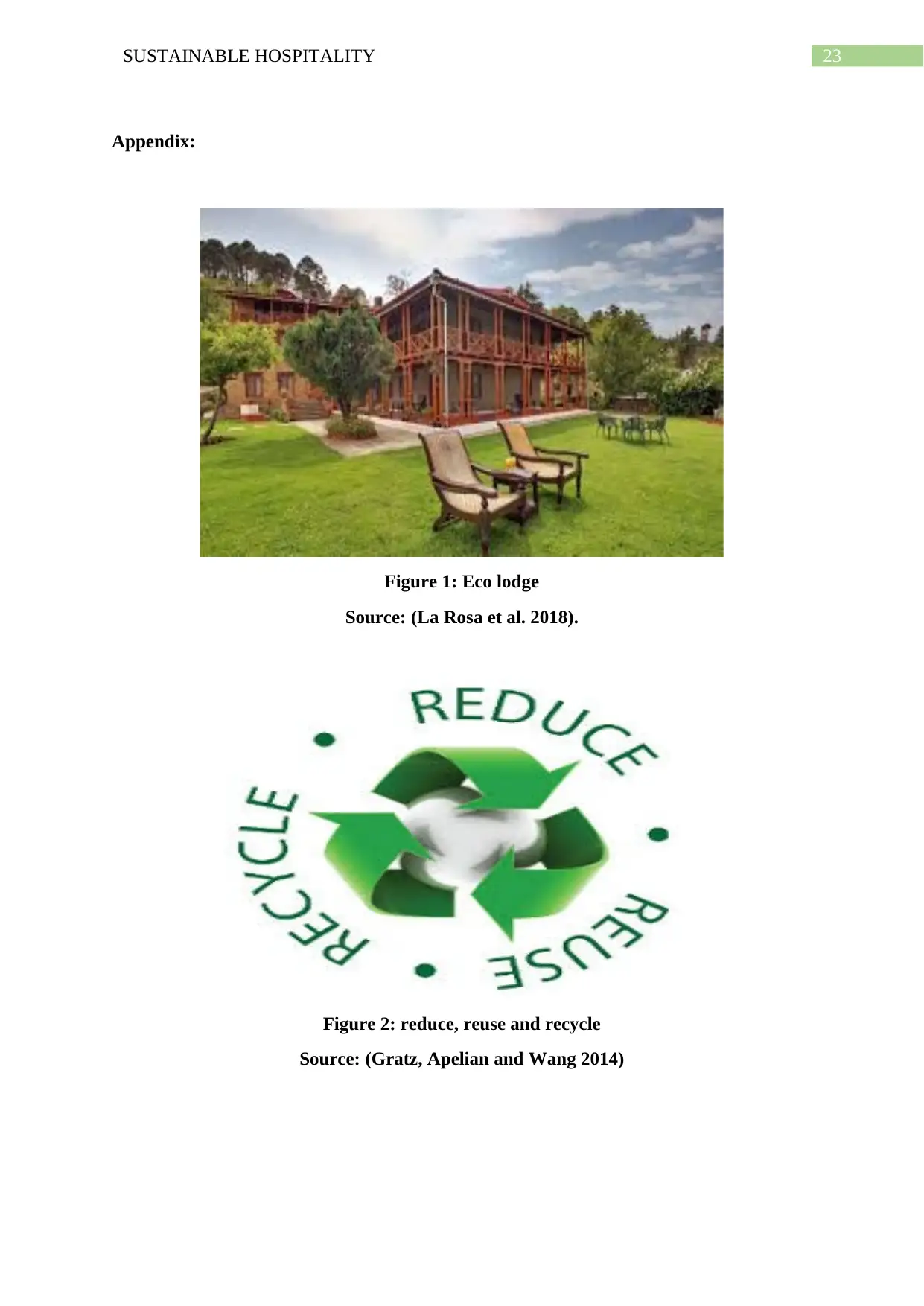
23SUSTAINABLE HOSPITALITY
Appendix:
Figure 1: Eco lodge
Source: (La Rosa et al. 2018).
Figure 2: reduce, reuse and recycle
Source: (Gratz, Apelian and Wang 2014)
Appendix:
Figure 1: Eco lodge
Source: (La Rosa et al. 2018).
Figure 2: reduce, reuse and recycle
Source: (Gratz, Apelian and Wang 2014)
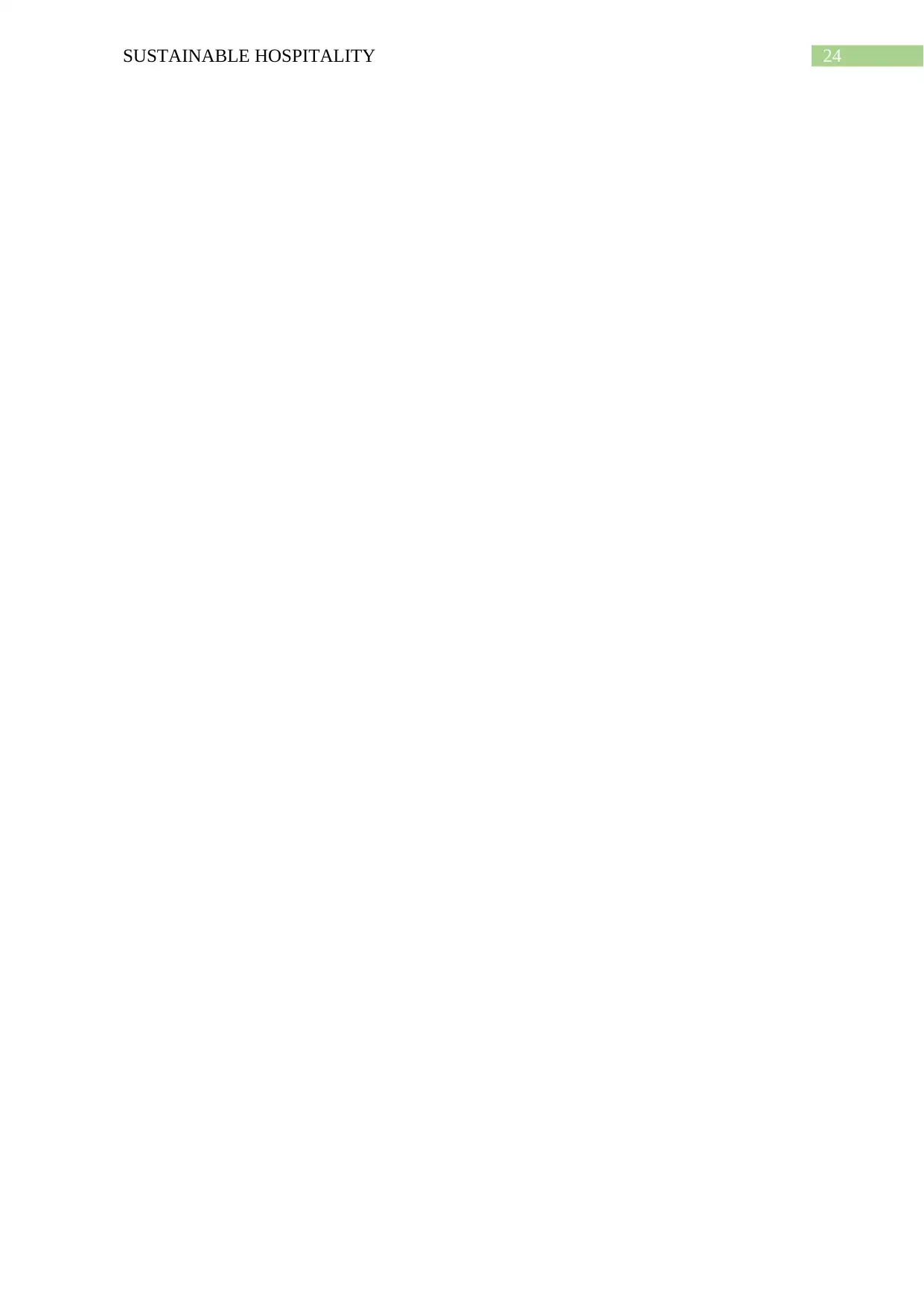
24SUSTAINABLE HOSPITALITY
1 out of 25
Related Documents
Your All-in-One AI-Powered Toolkit for Academic Success.
+13062052269
info@desklib.com
Available 24*7 on WhatsApp / Email
![[object Object]](/_next/static/media/star-bottom.7253800d.svg)
Unlock your academic potential
© 2024 | Zucol Services PVT LTD | All rights reserved.





